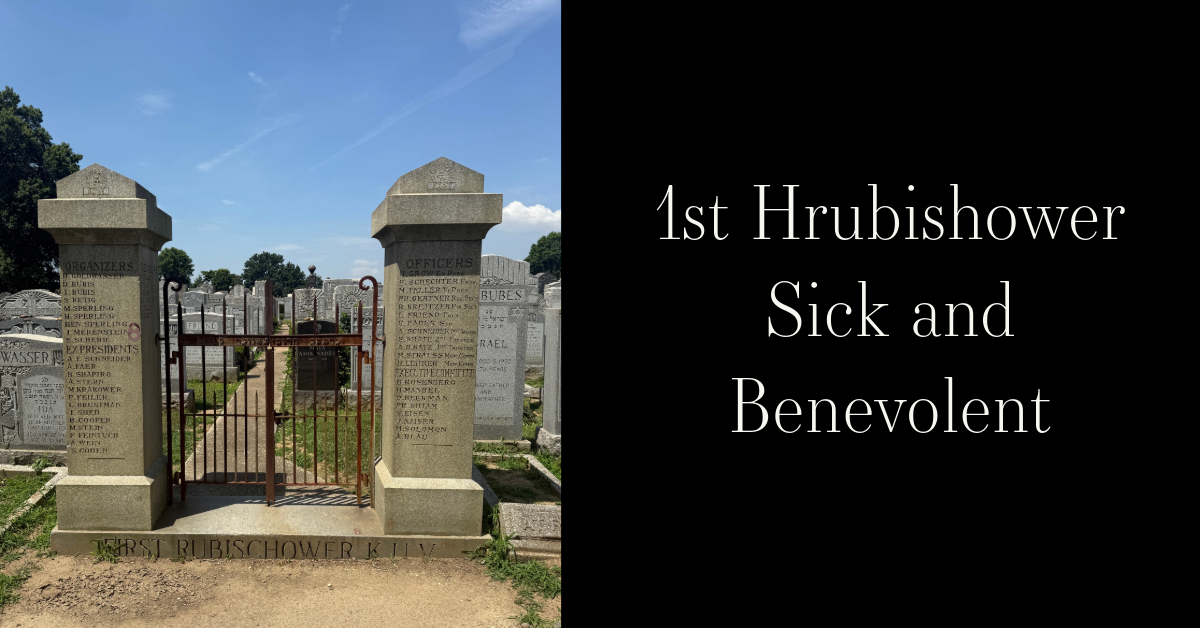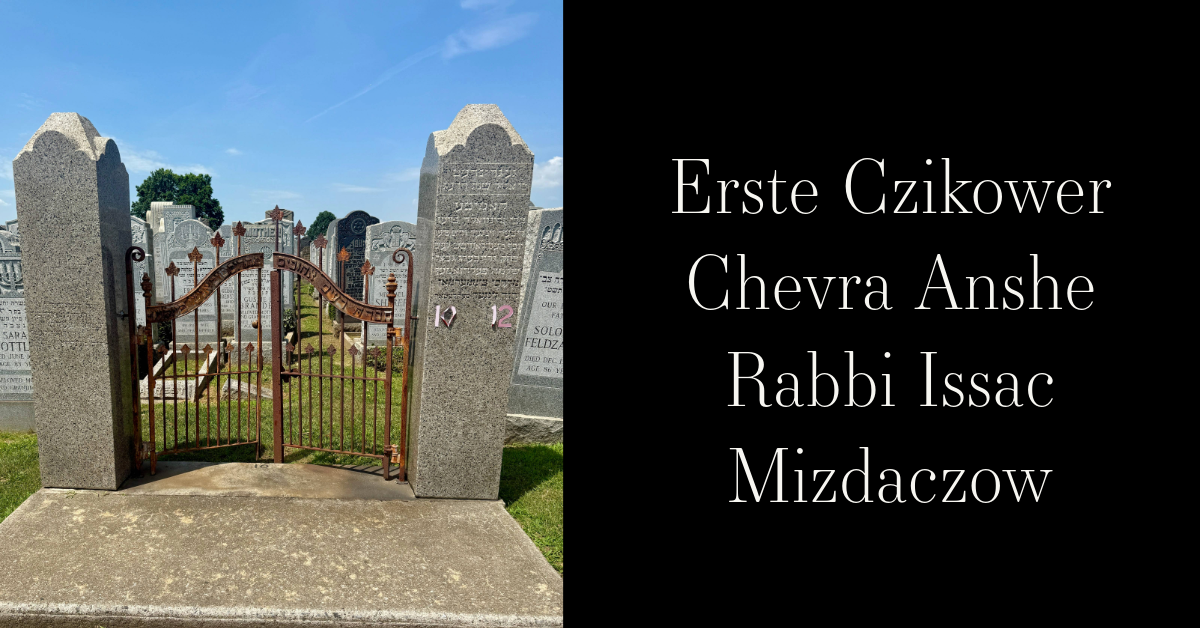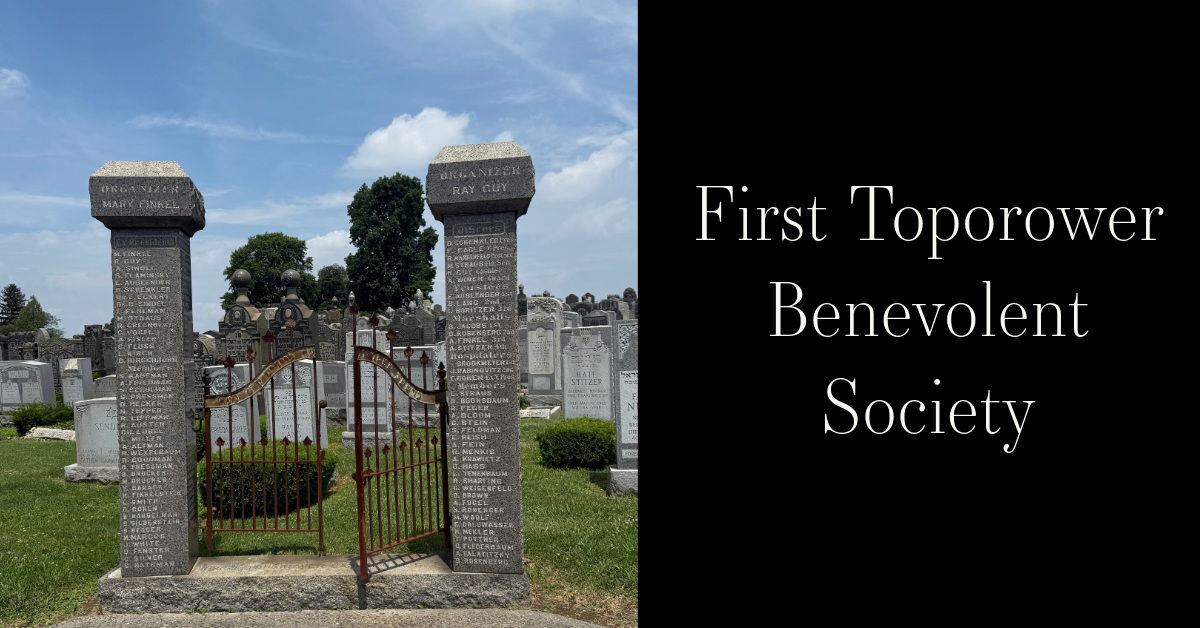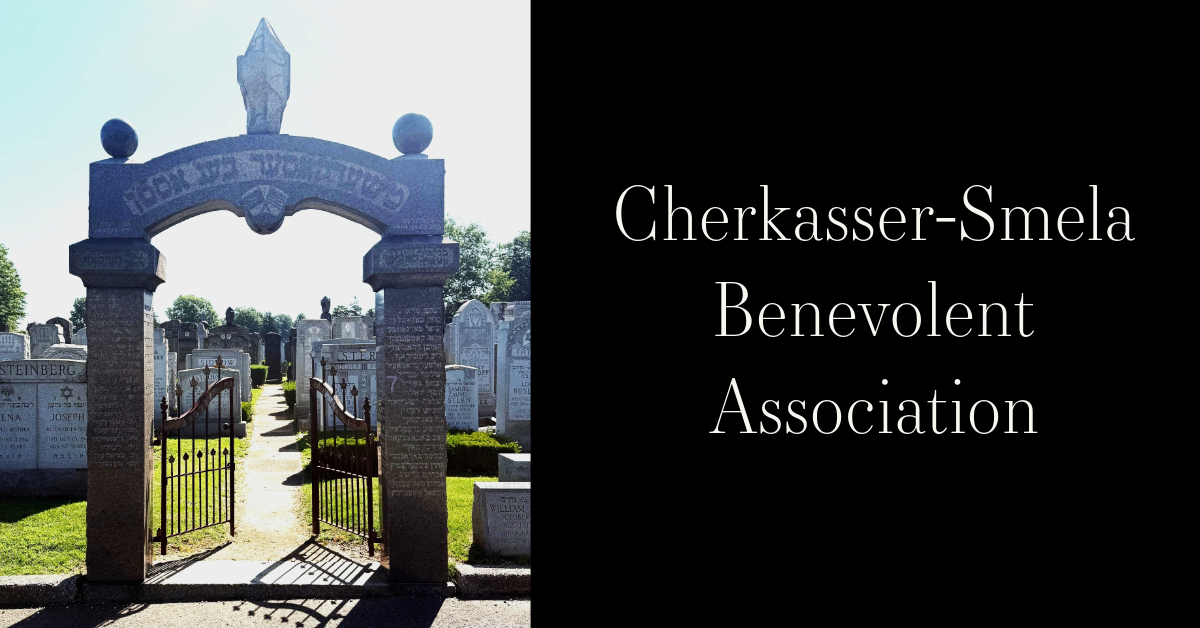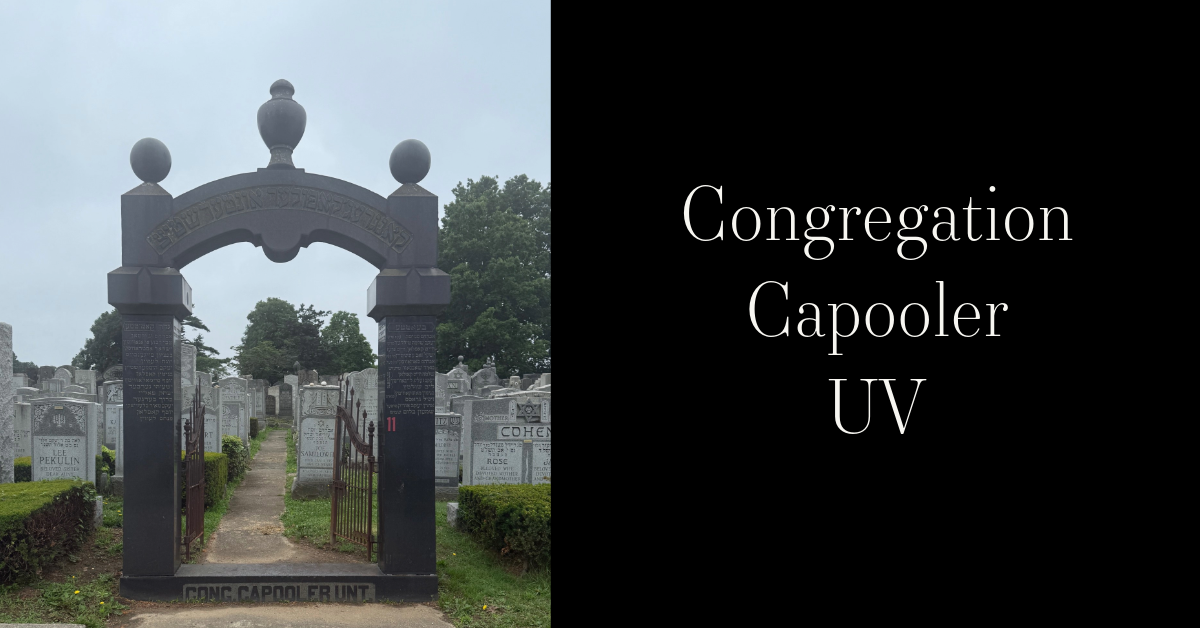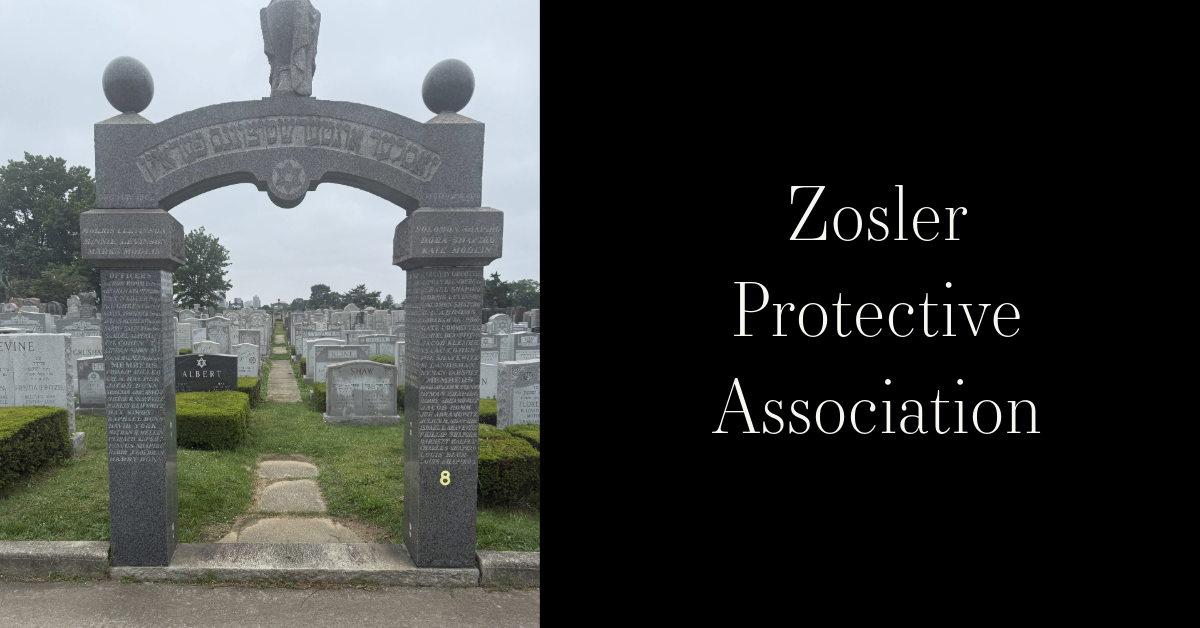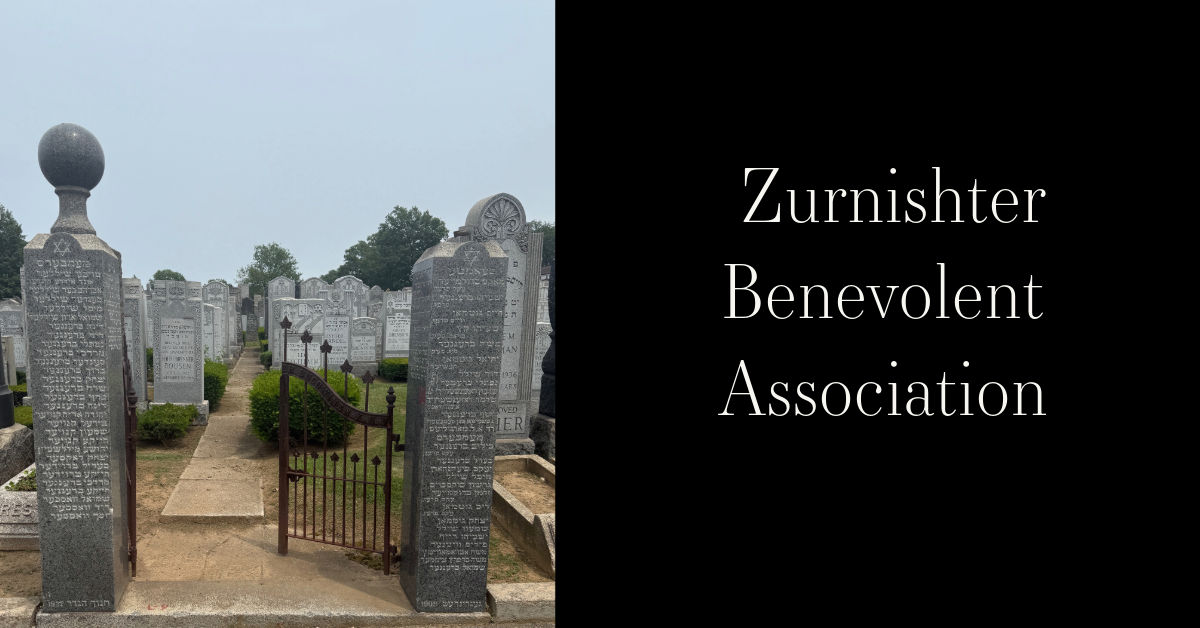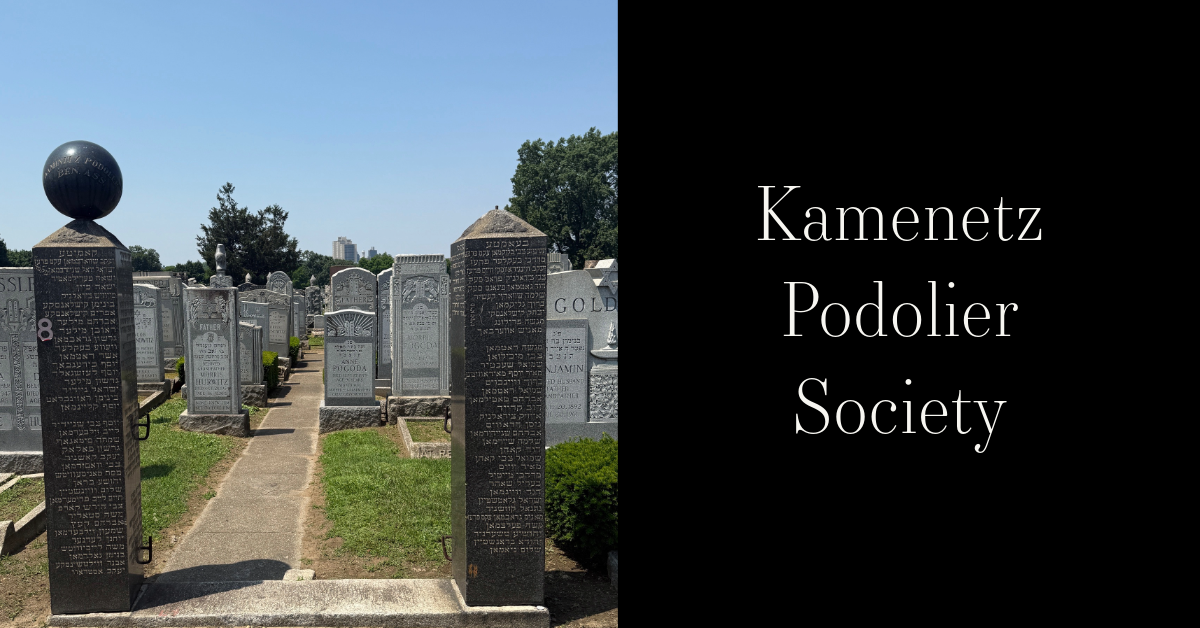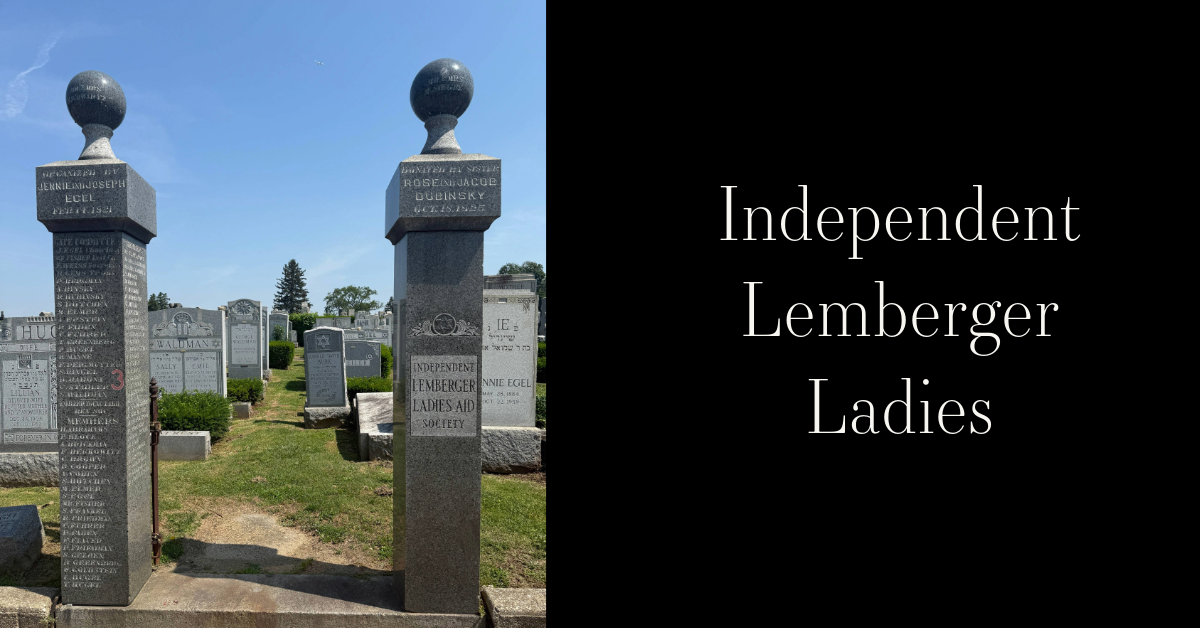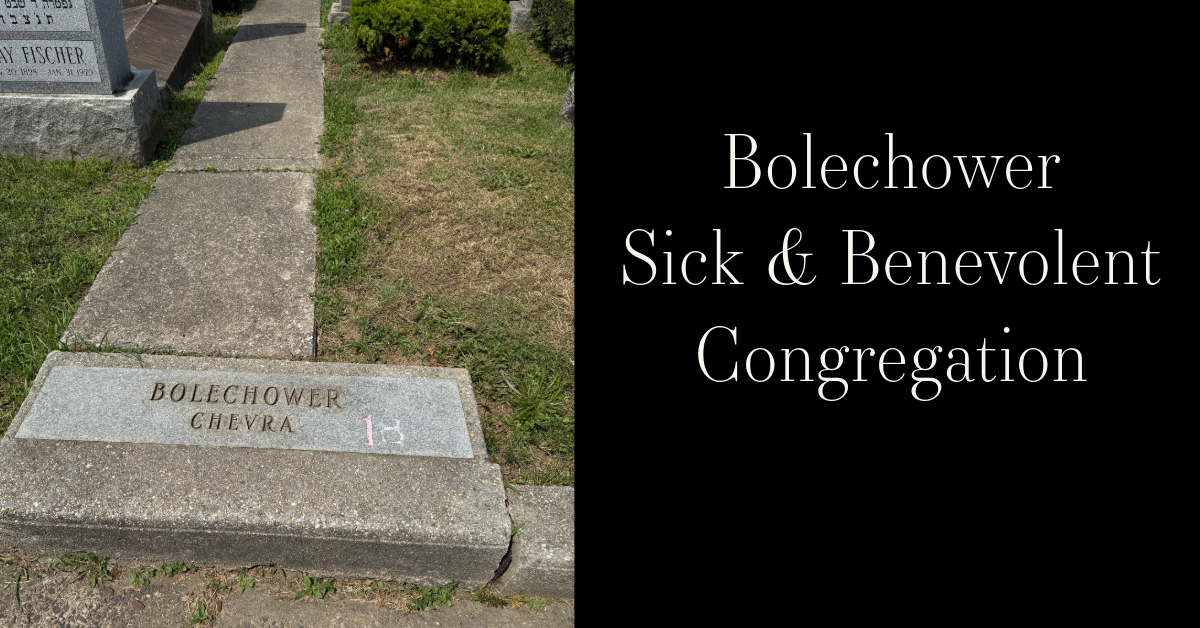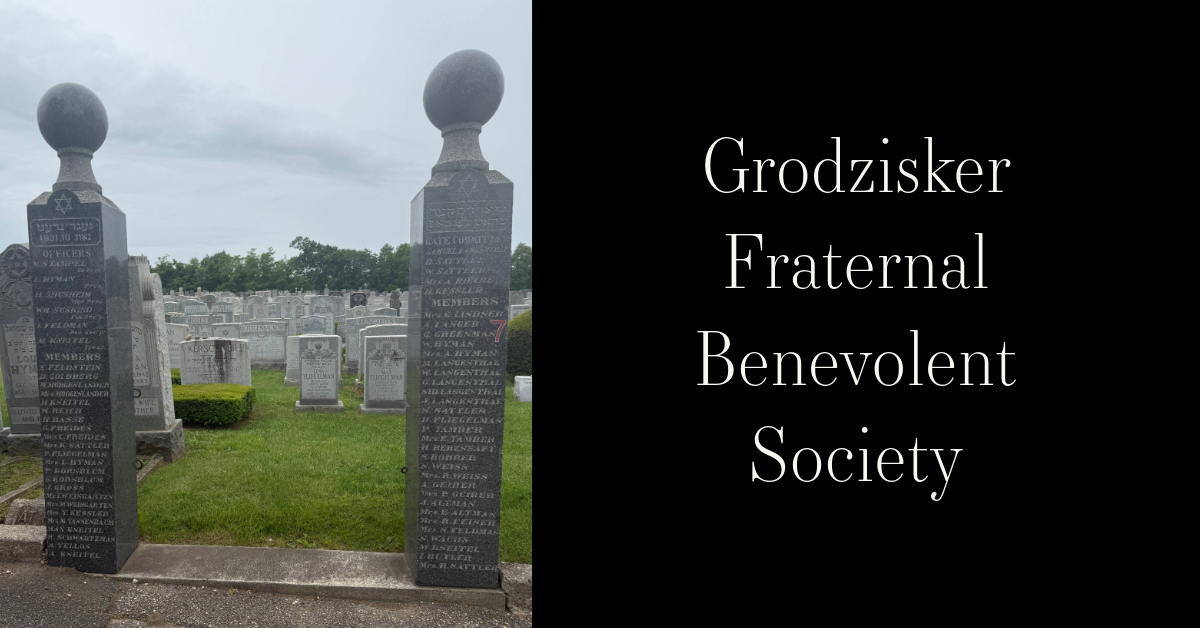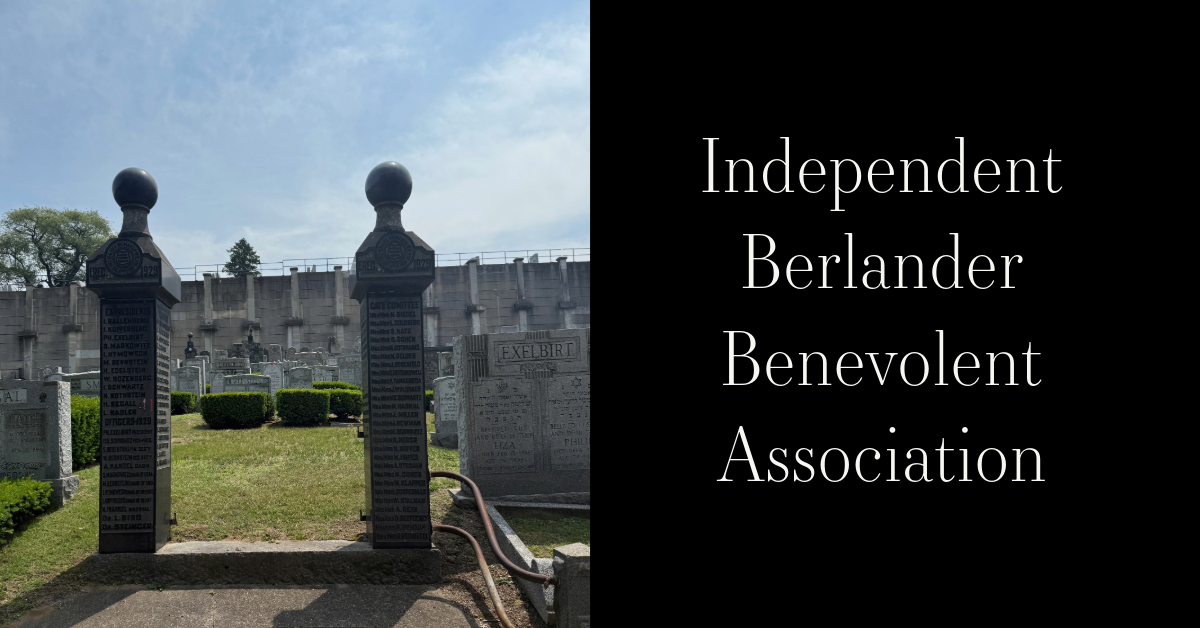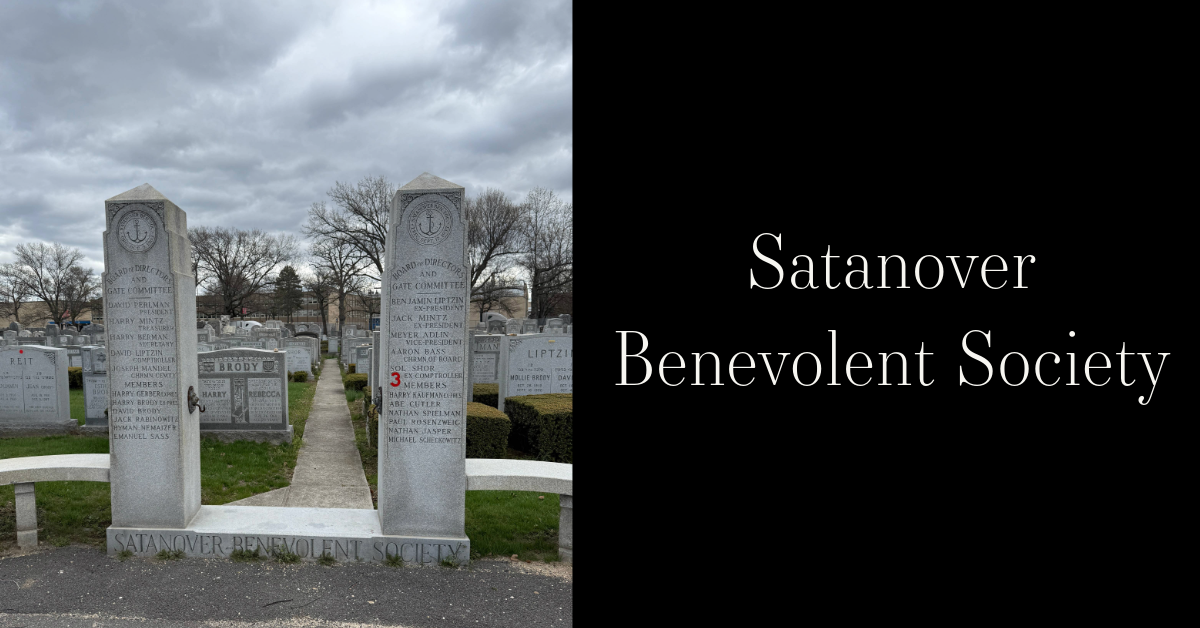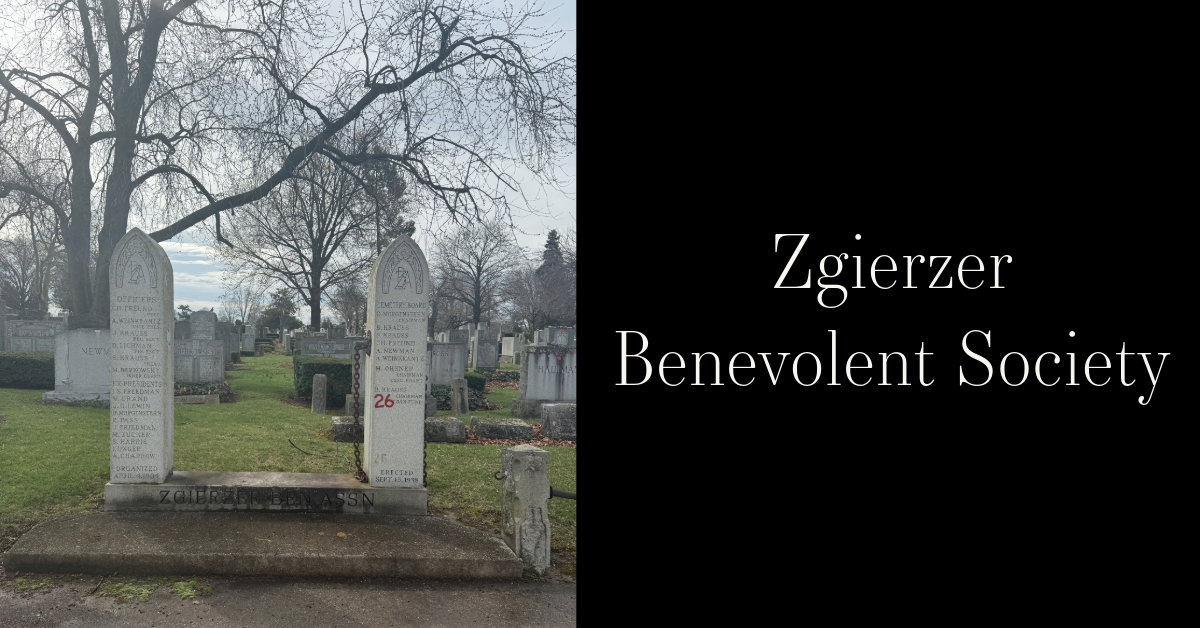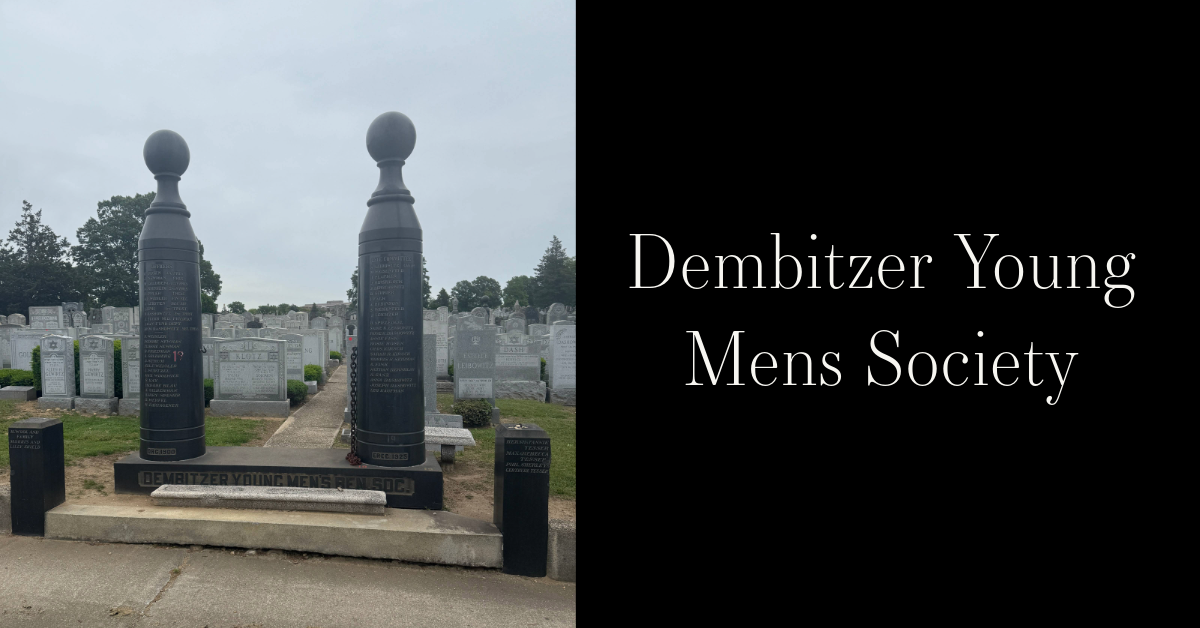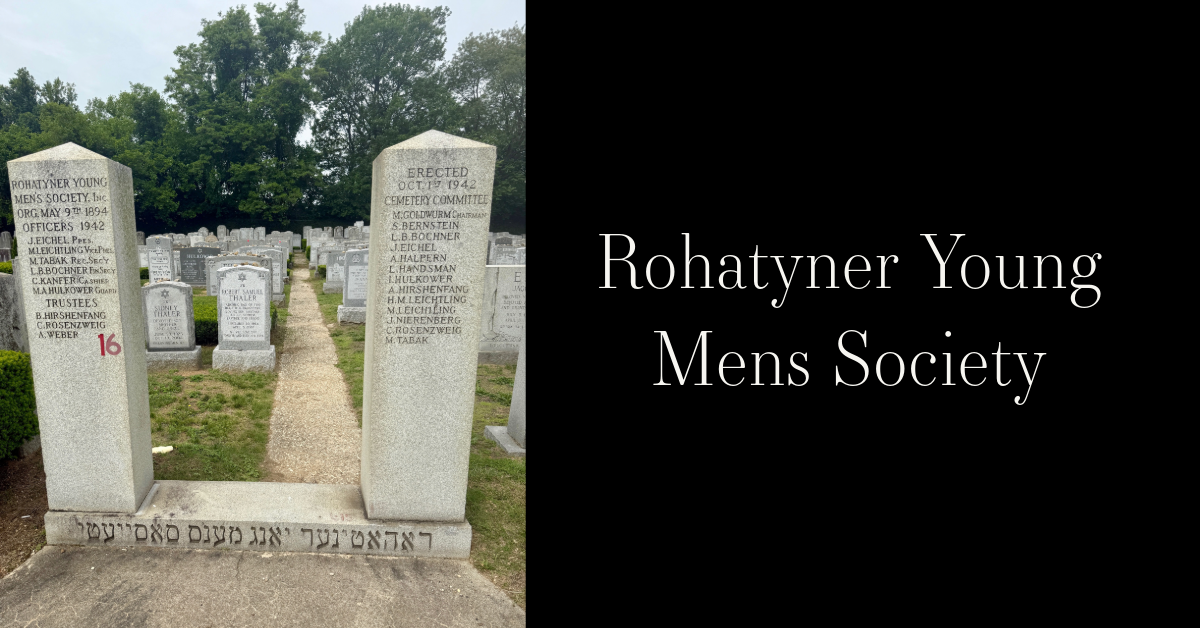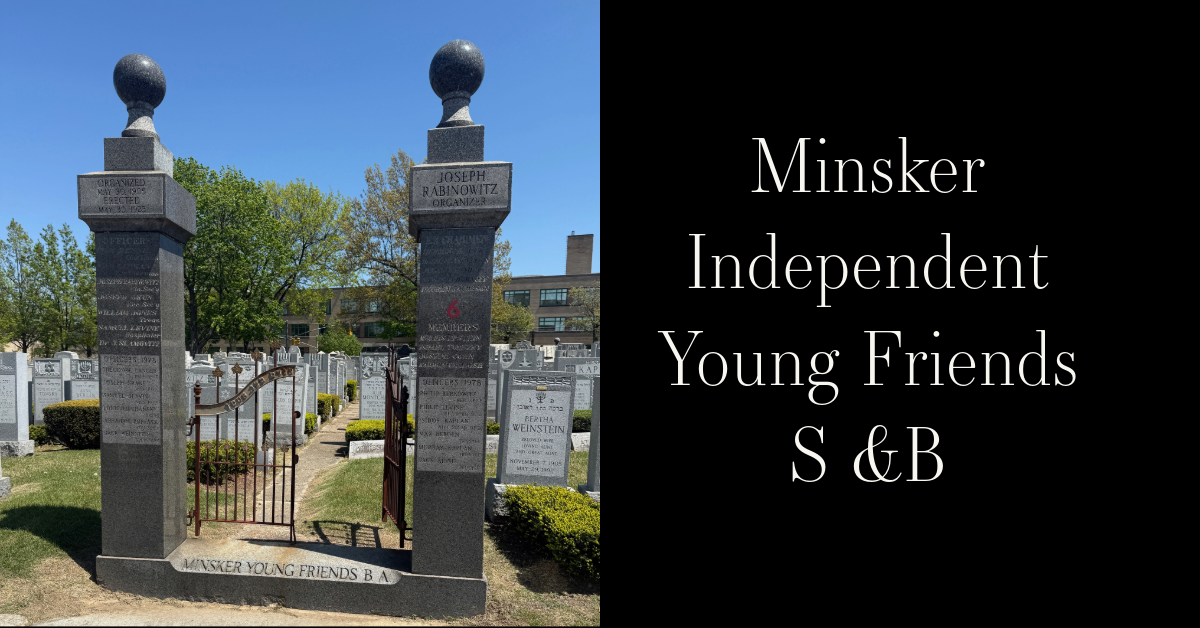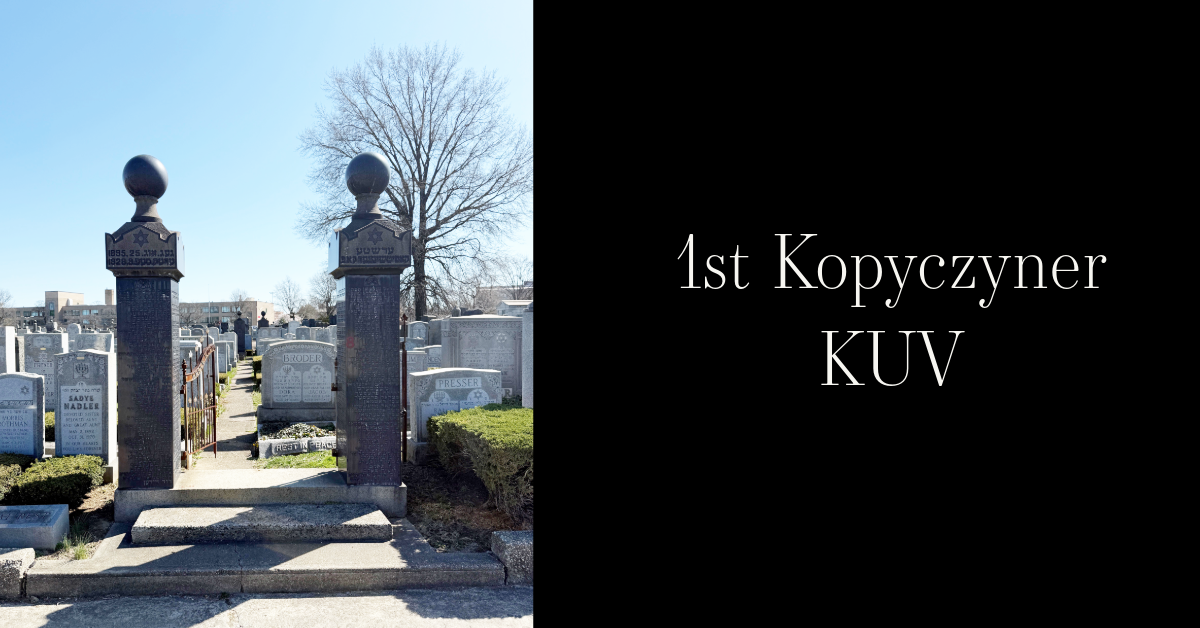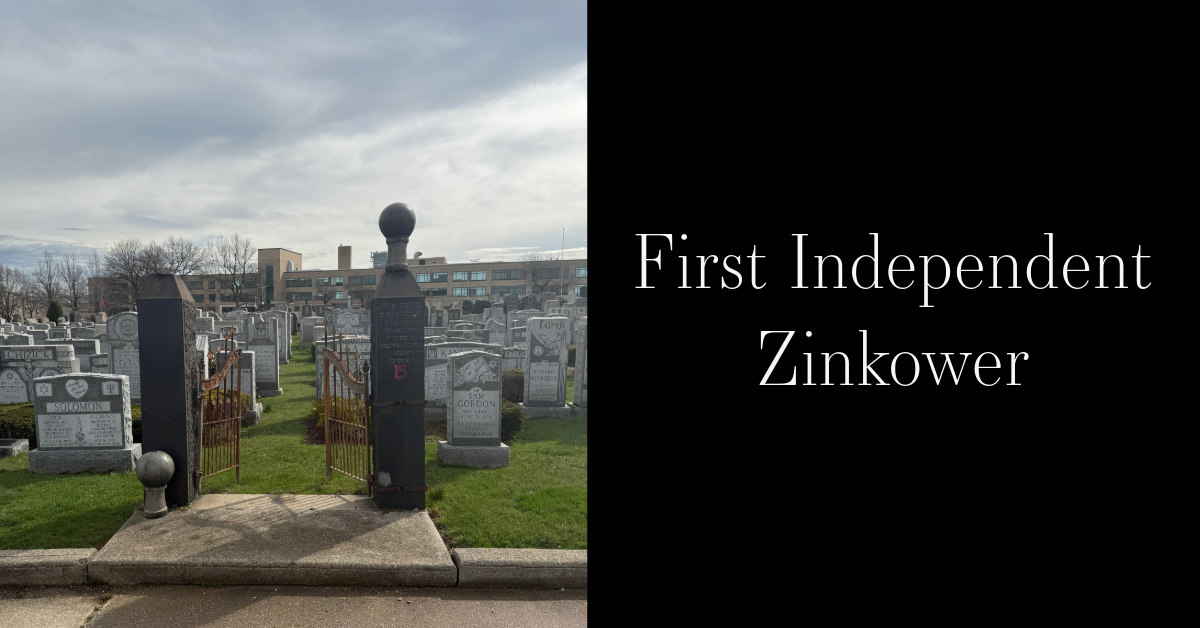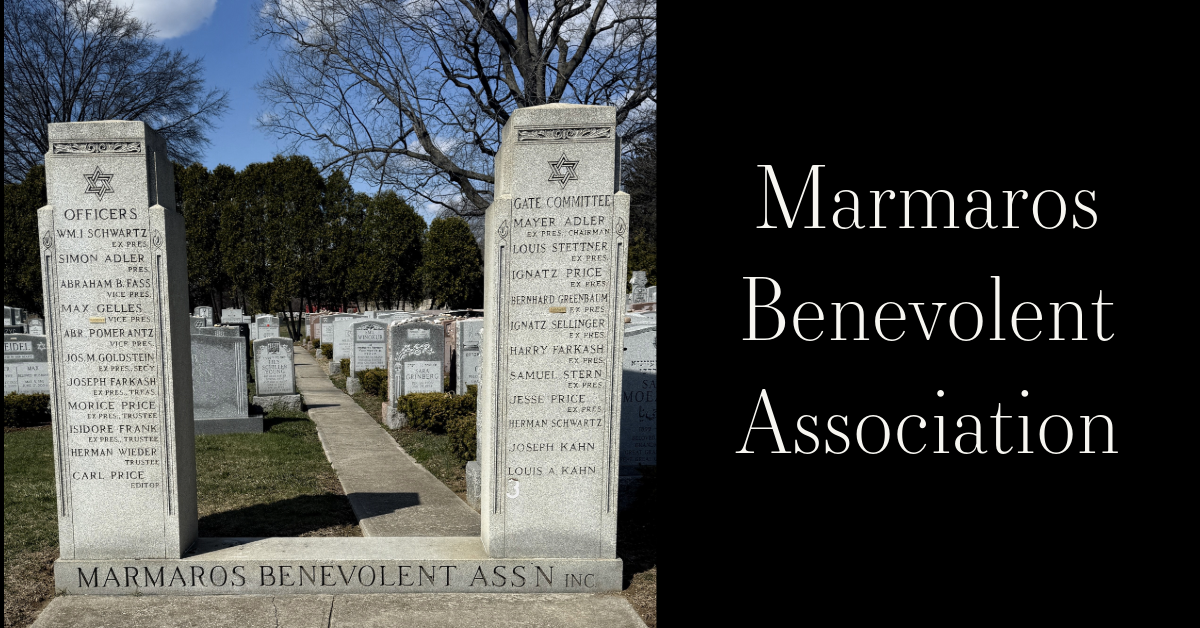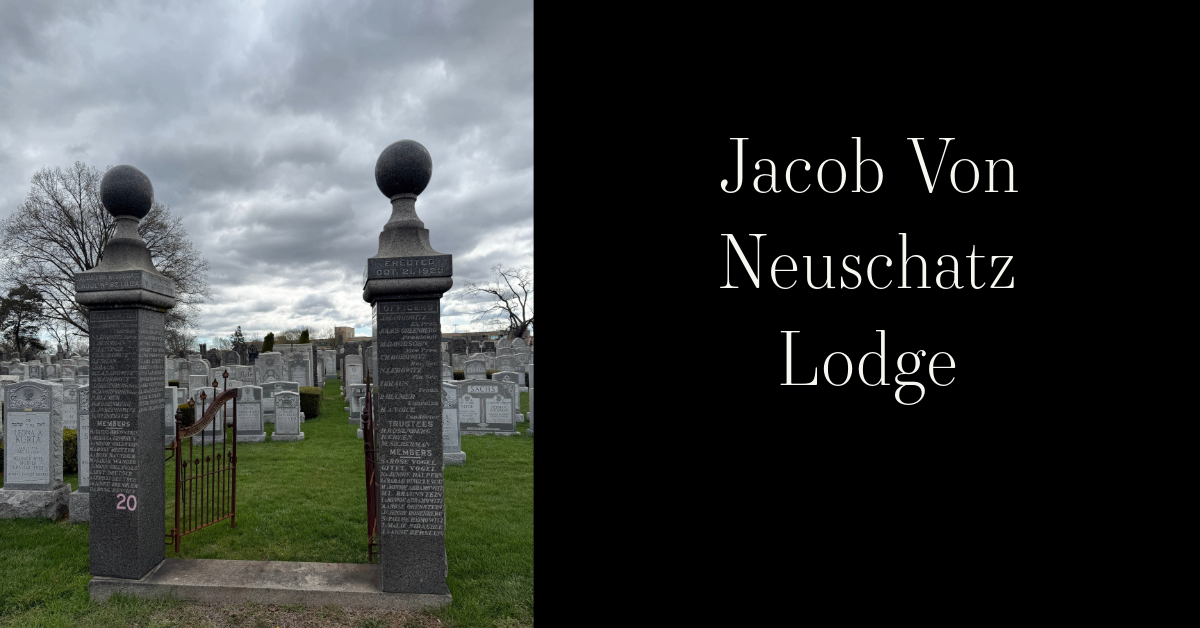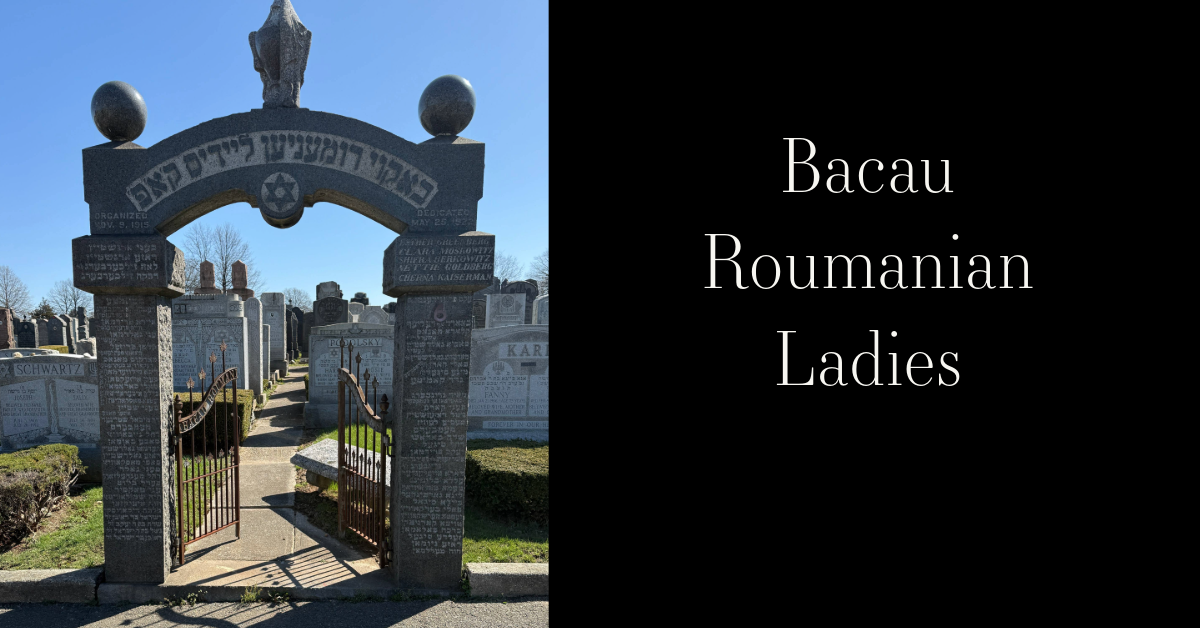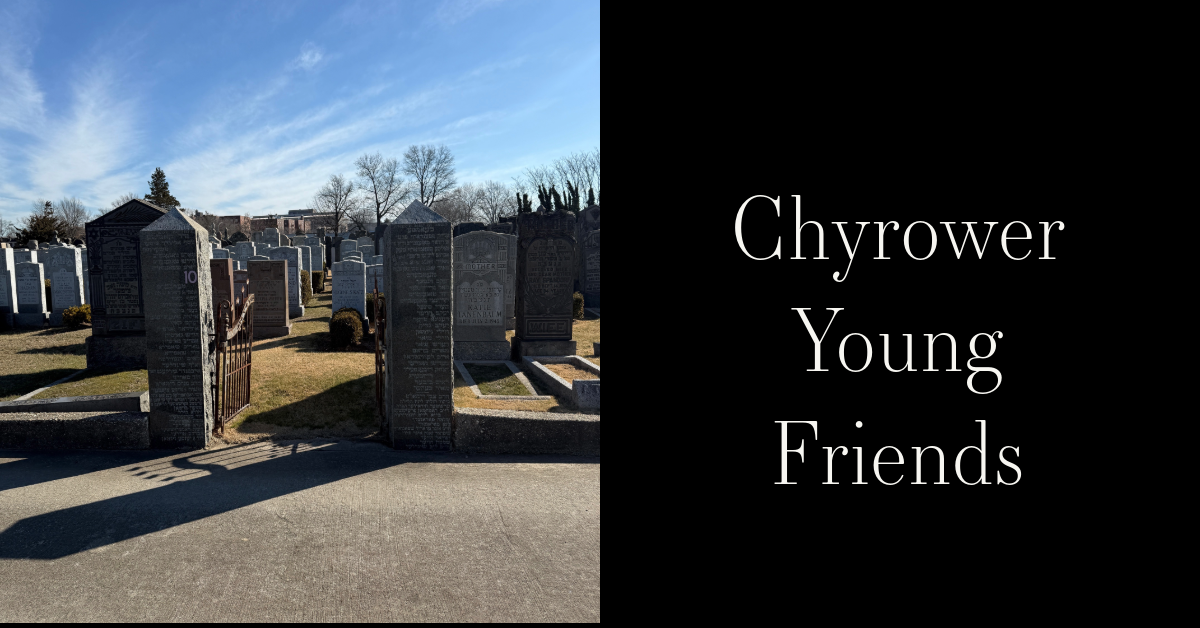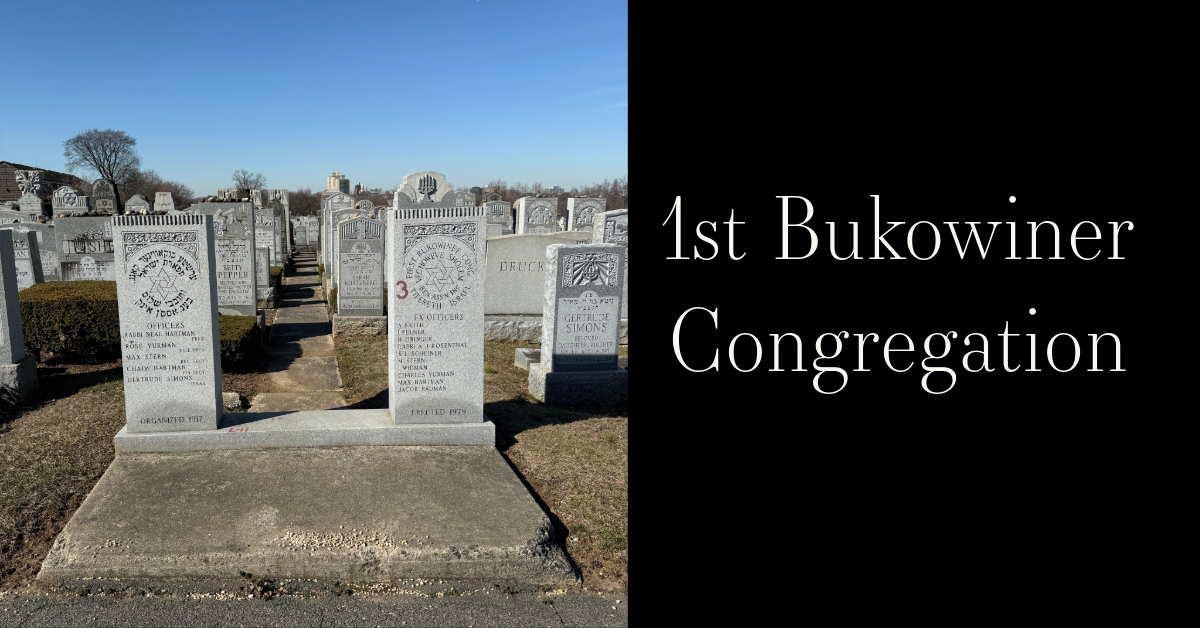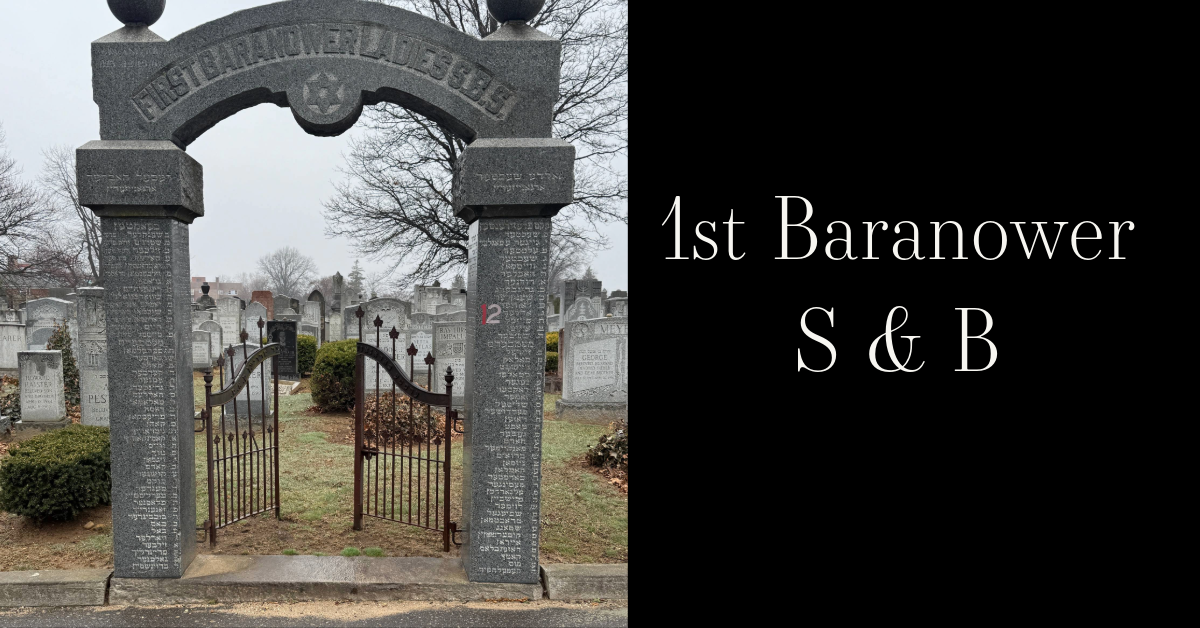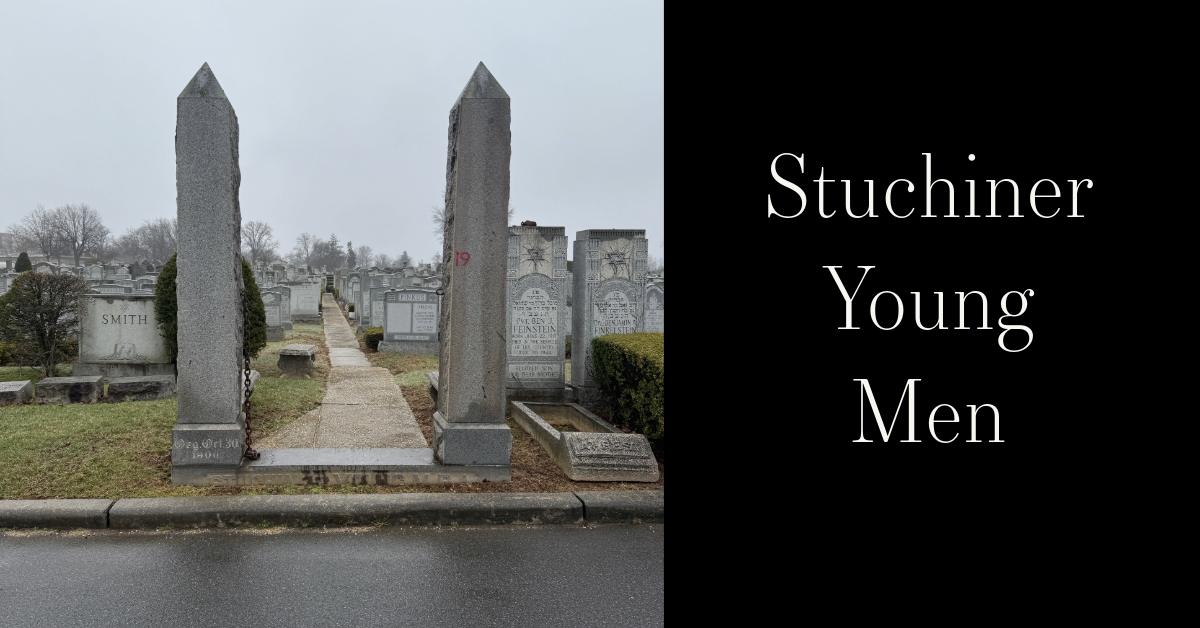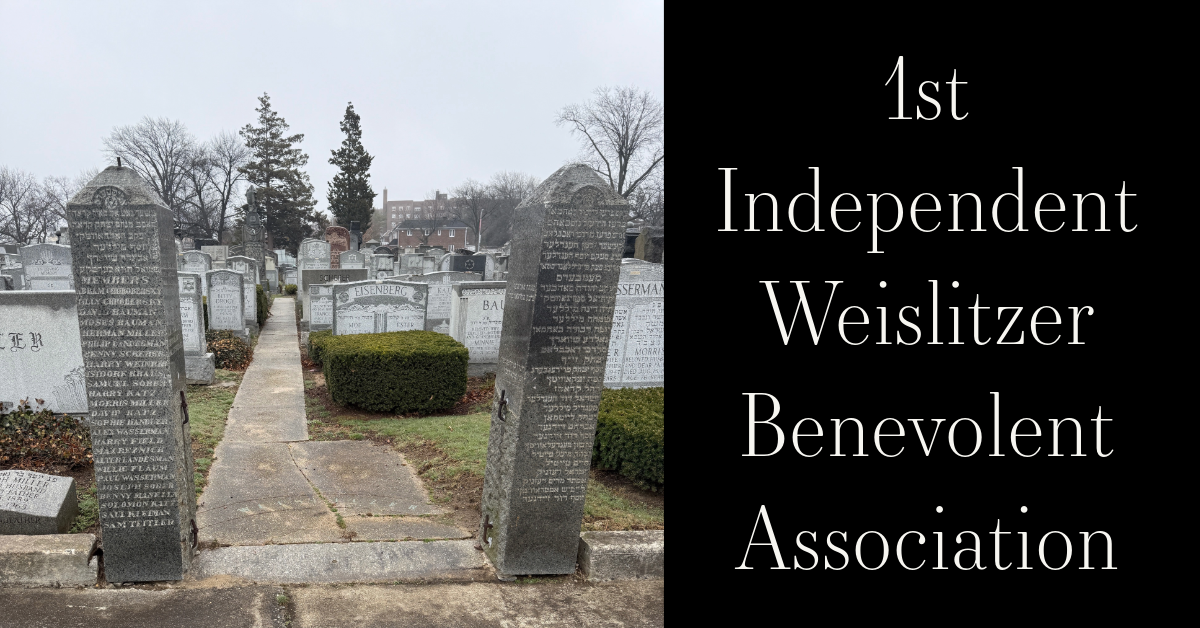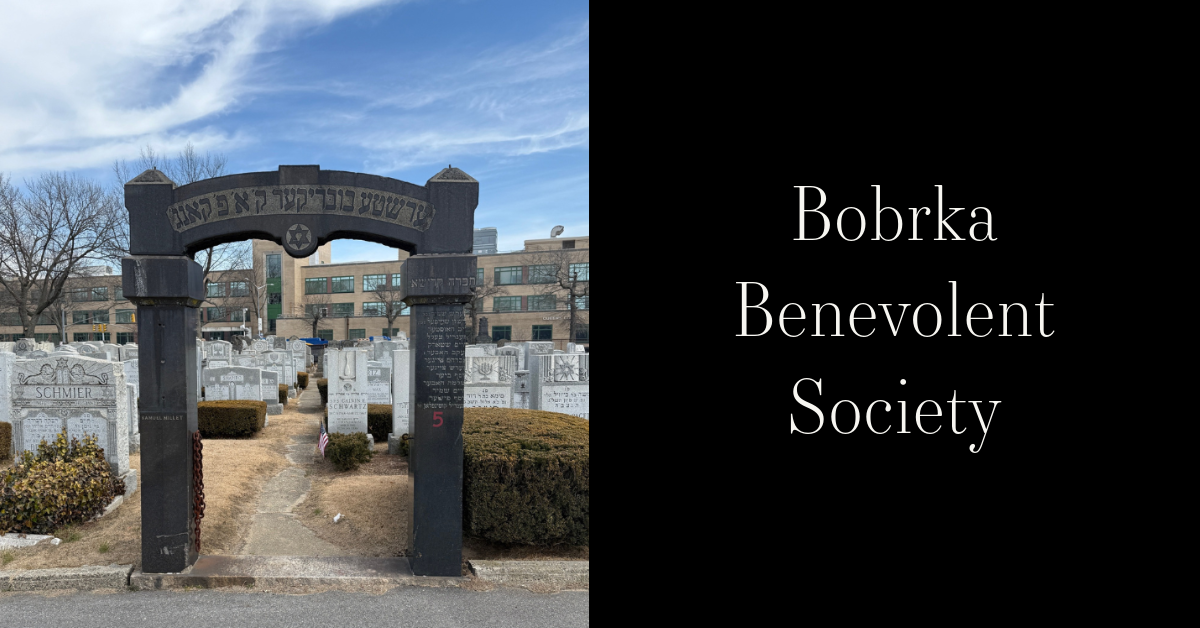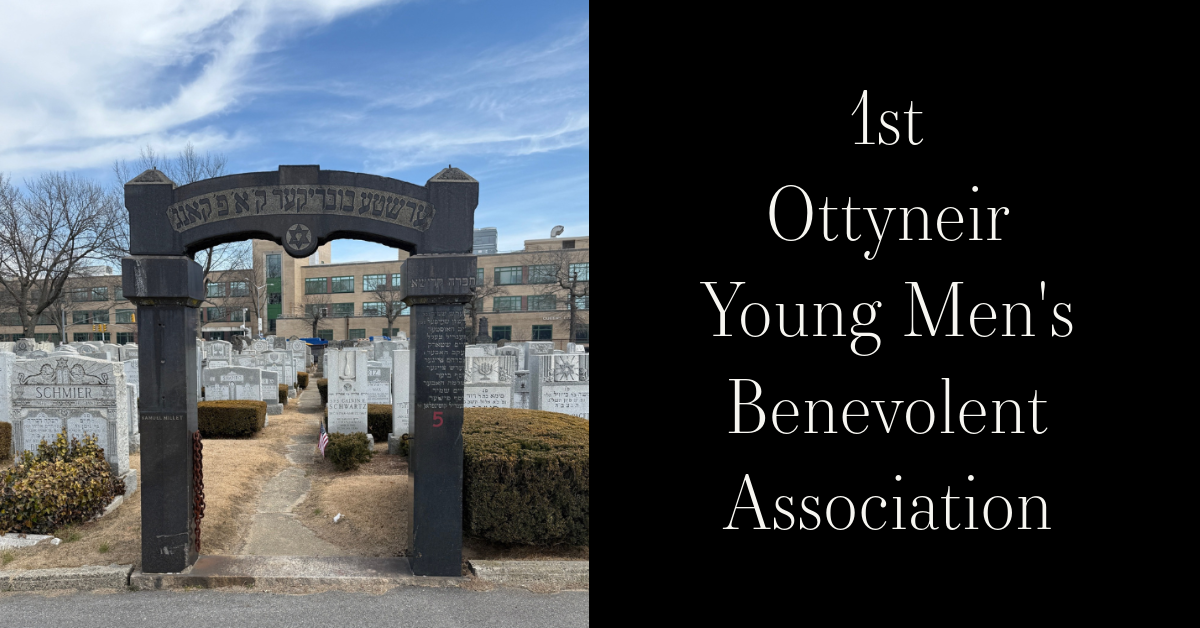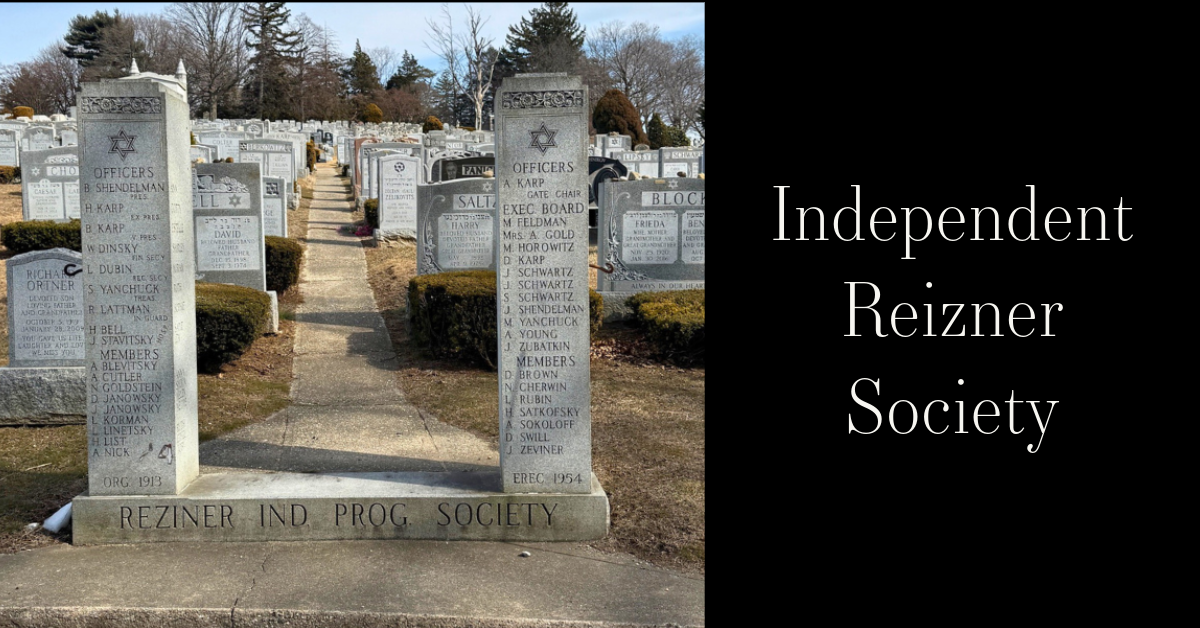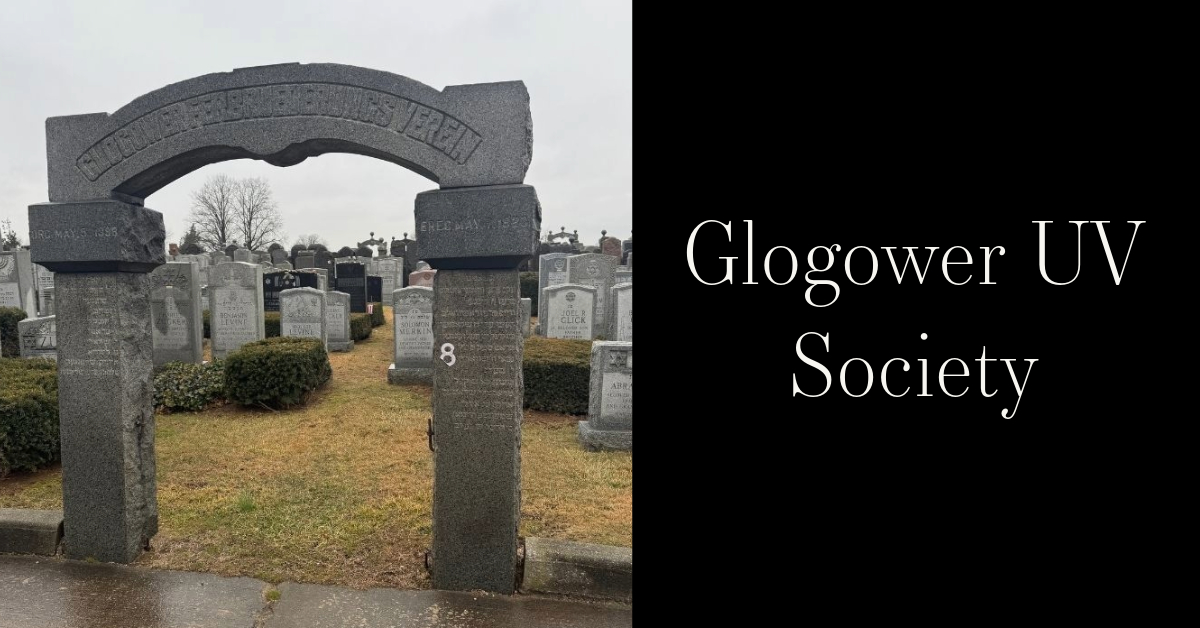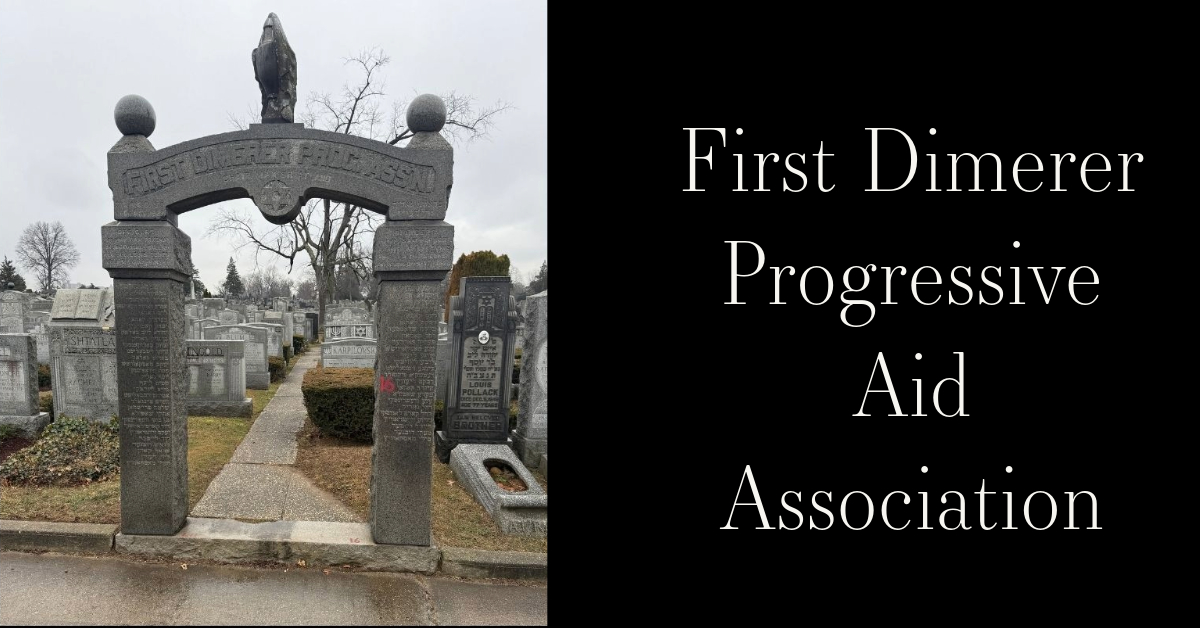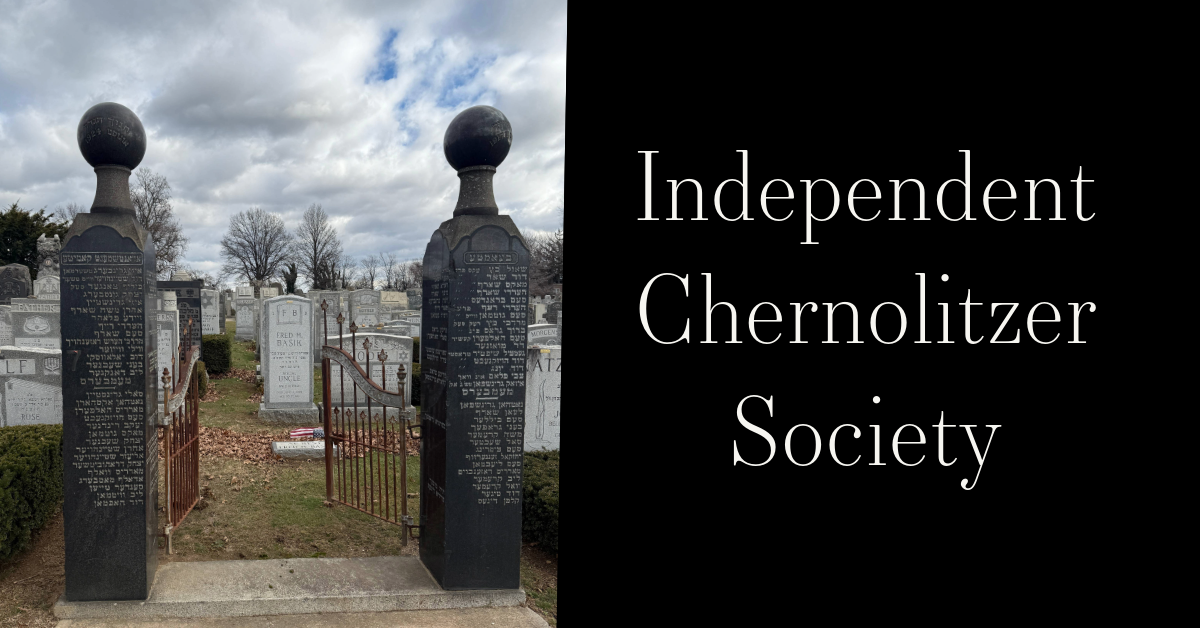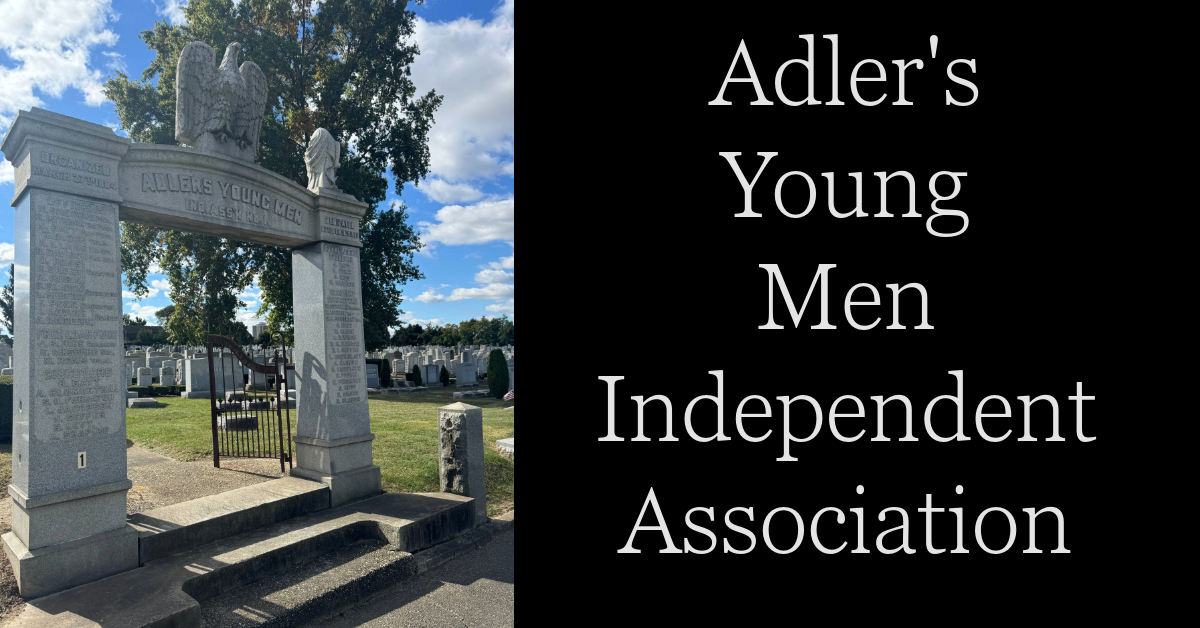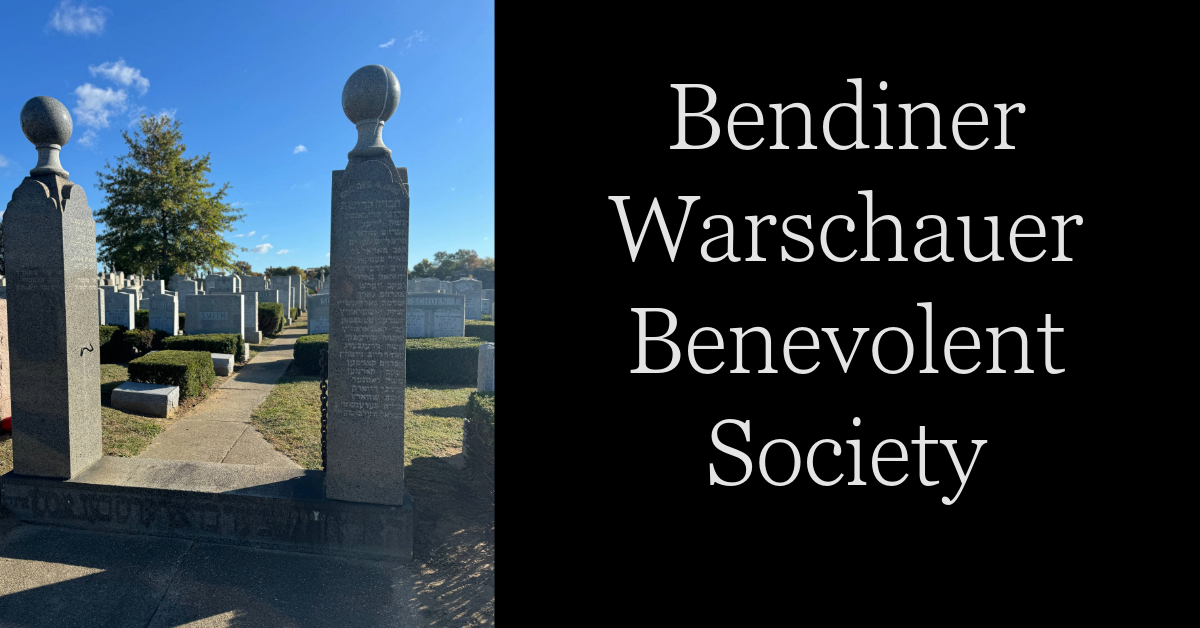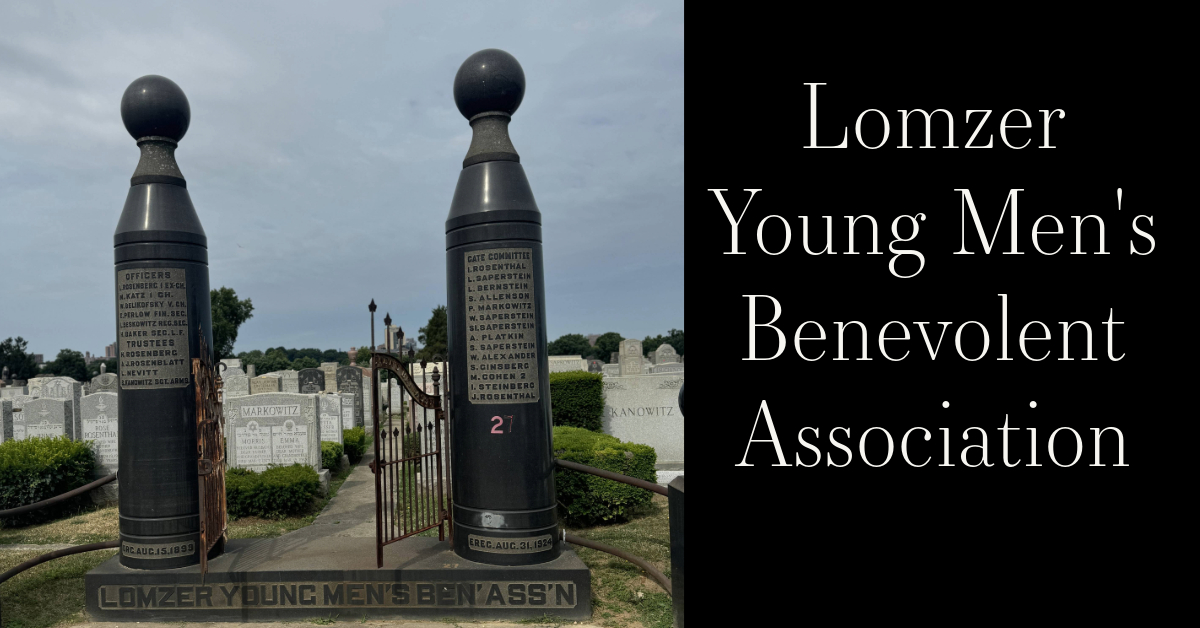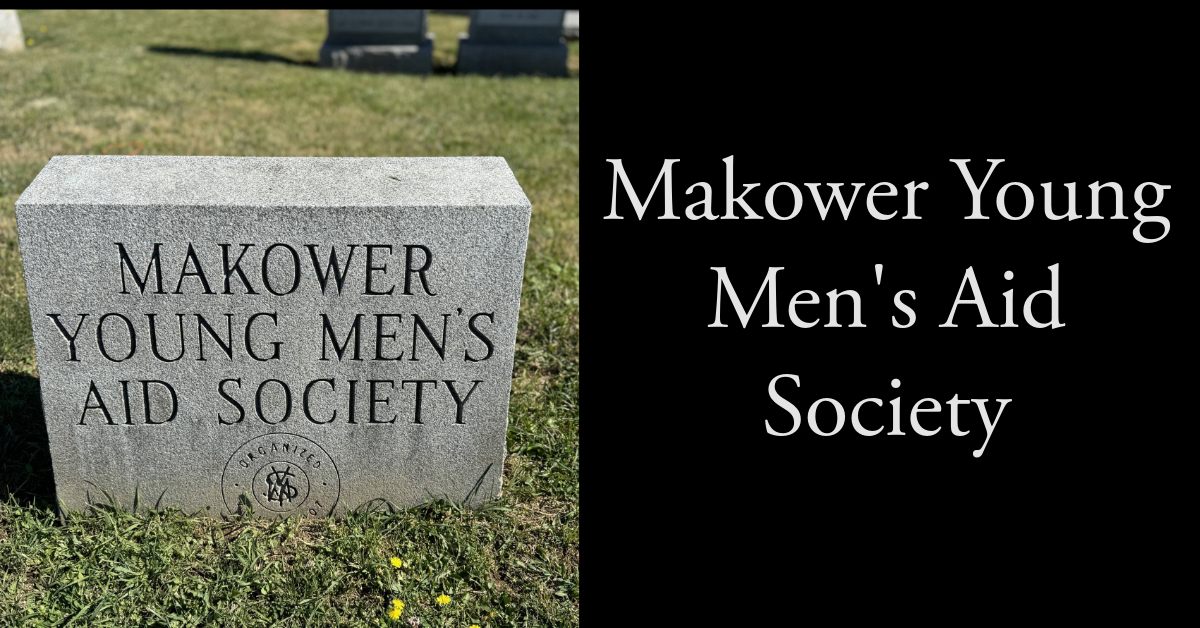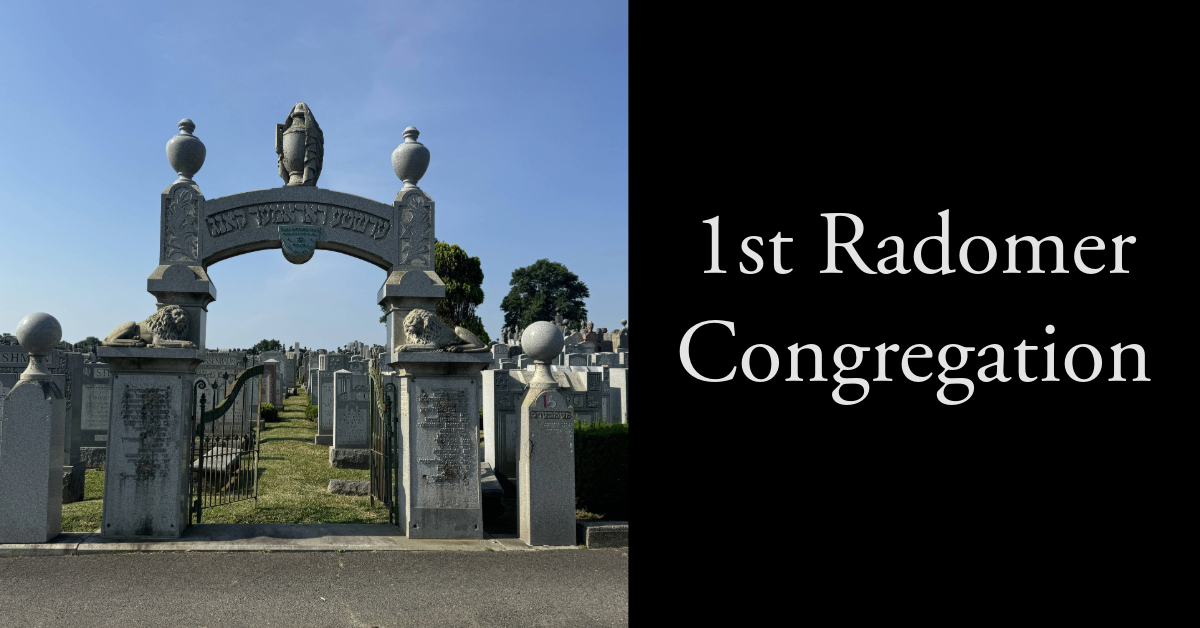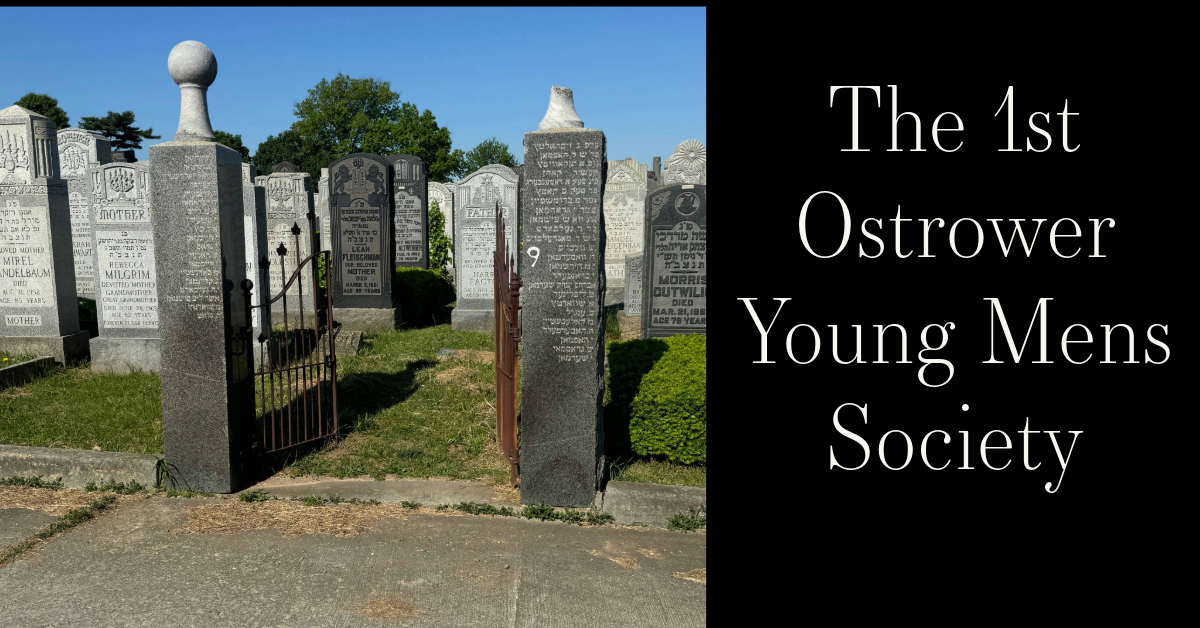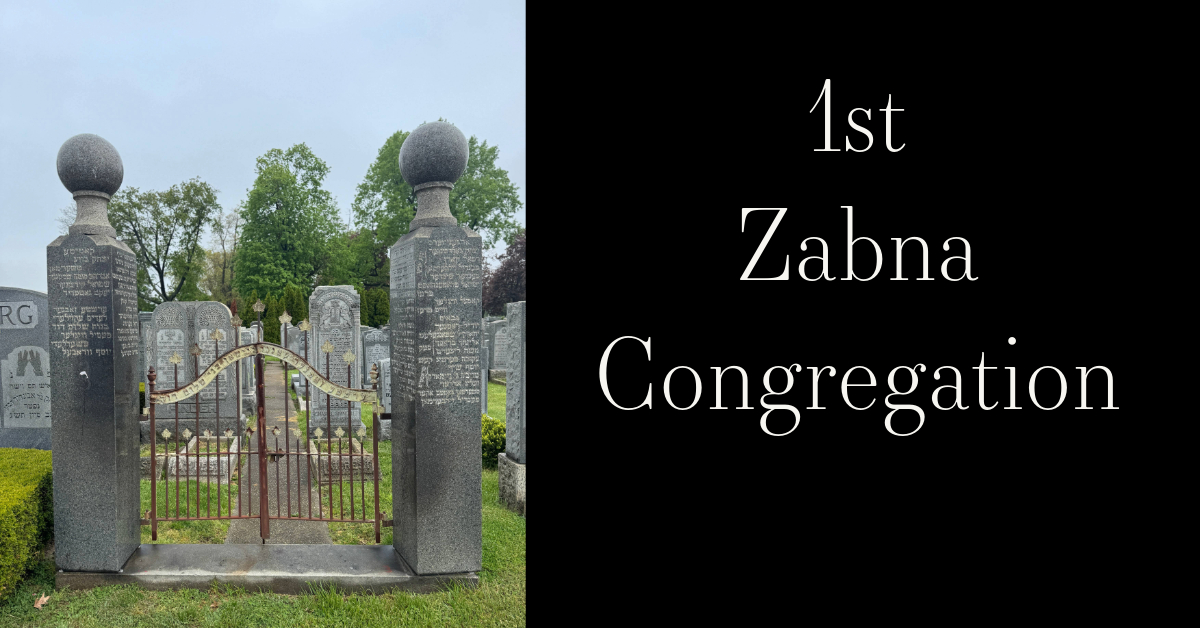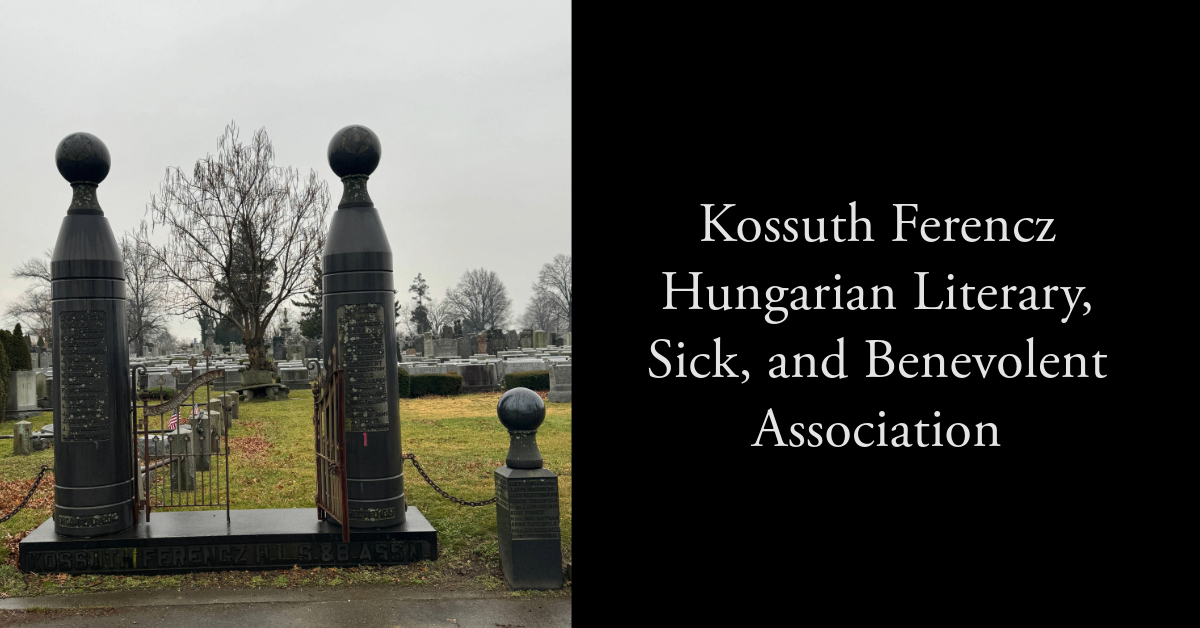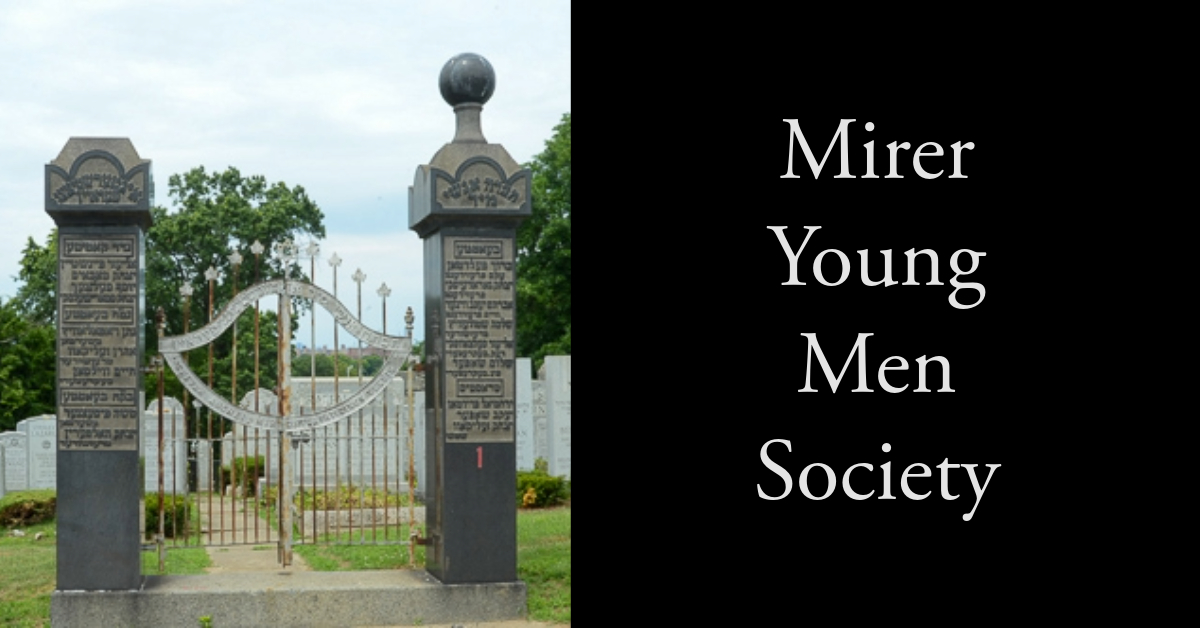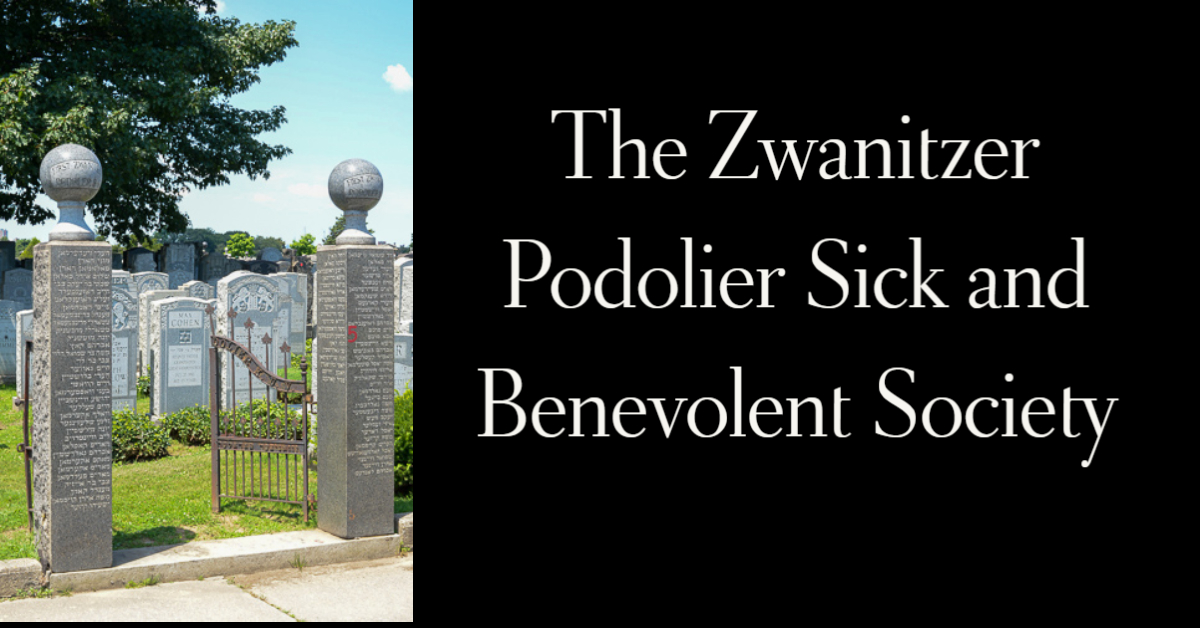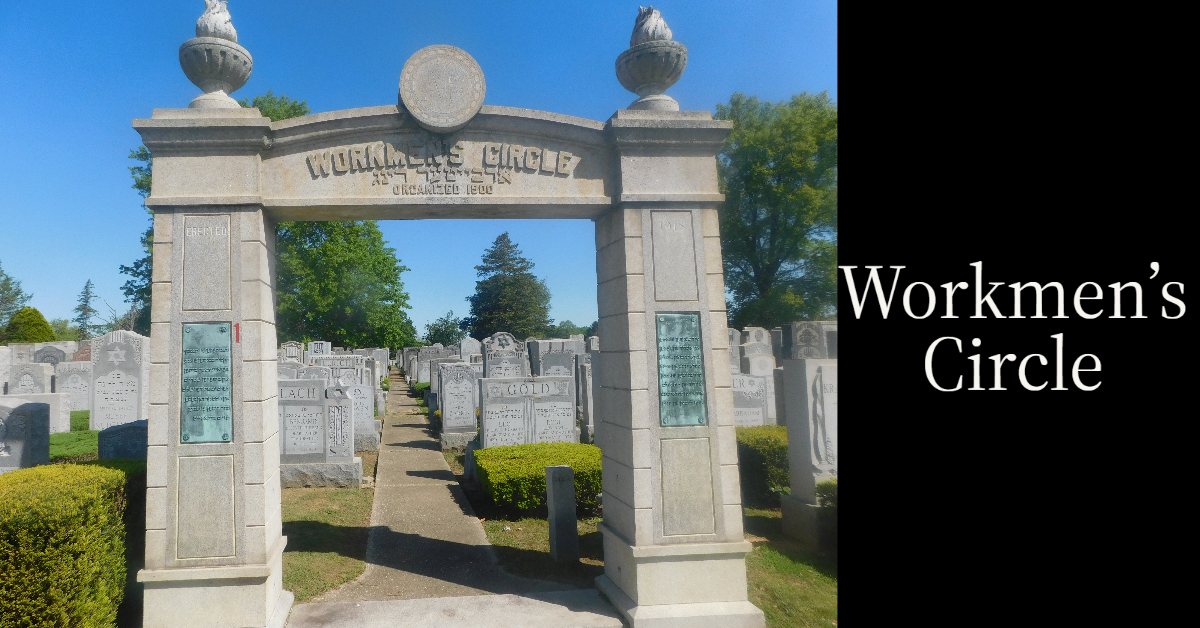Hebron's Stories
If a story is important, then it must be told. We can portray dreams of what the future may hold, or allow introspection on what has occurred in the past. A story is a narrative that can relay lessons and warnings. A story can teach us about hope and remind us how important and meaningful our lives are. We are unearthing stories about those buried at Mount Hebron Cemetery.
The 1st Hrubishower Sick and Benevolent Blog was established in 1904 in New York by immigrants hailing from Hrubishov (Hrubieszow), Poland. The society provided sick and death benefits to its members. They have subsidized burial at Mt. Zion, Mt. Hebron, and Montefiore Cemeteries. Jewish settlement in Hrubieszow dates to the mid-1400s, with many working in trade. The town and its community suffered greatly from the Tatar invasions, Cossack invasions, 1863 Polish uprising, and the 1736 town fire. Despite this, the community persevered, establishing various religious and education institutions, and contributing to the town's industrial development. Hrubieszow's Jewish community perished under German occupation. Their memories live on. ~Blog by Olivia Scanlon
Learn More
The Erste Czikower Chevra Anshe Rabbi Issac Mizdaczow Society was established in New York in 1913 by immigrants hailing from Dzikow Stary, Poland. (According to "JewishGen", the town of Tarnobrzeg was also known by the name of Dzikow in the 1765 census, so their histories are often mixed - but for the sake of accuracy, this blog will focus on the town of Dzikow Stary). Jews were inhabiting the town by the 18th century, with many working as farmers. Many Jews were attracted to the town for its Chassidic Center. The Jews of Dzikow perished following the German invasion of Poland in 1939. Their memories live on. ~Blog by Olivia Scanlon
Learn More
The First Toporower Ladies Sick and Benevolent society was established in 1912 in New York by immigrants hailing from Toporow (Toporov), in the Austrian Empire (now Western Ukraine). The society provided aid to the sick, and assisted with burial needs. Jewish presence in Toporower dates to the town's founding in 1603. Sections of the town were repeatedly destroyed from sporadic fires occurring during the late 19th century/early 20th century. Conditions for the Jews of Toporow did not begin to improve until the interwar period (1918-1939). The Jewish community of Toporow perished following German occupation (1941-1944). Their memories live on. ~Blog by Olivia Scanlon
Learn More
The Cherkasser-Smela Benevolent Association was formed in 1962 by immigrants from Smela, Ukraine and Cherkassy, Ukraine. This society was founded through the consolidation of the United Brothers of the town of Smila (incorporated in 1906) and the Cherkasser Benevolent Association (incorporated in 1945). The United Brothers established the Relief Committee for the Smeler Political Convicts, 1913 and the Joint Smela Relief, Inc. 1928. Relief activities of the society included establishing barrel woodwork factories in Smela, 1930. This blog provides a history for both towns. ~Blog by Olivia Scanlon
Learn More
The Congregation Capooler Unterstitzung Verein society (a.k.a the Kapuler UV) was founded in New York in the 1890s by immigrants hailing from Kopyl (Kapoli, Kapolia, Kapulye, Kopil), Belarus (previously part of the Russian Empire). The society provided endowment funds in addition to sick & death benefits for its members. ~Blog by Olivia Scanlon
Learn More
The Zosler Protective Association Society (Zosler Unterstutzung Verein) was established in New York by immigrants from Zasliai (Shosli, Zasla, Zasle, Zhosla, Zosli), in what is now Lithuania (previously part of the Russian Empire). It was incorporated in 1902, and provided its members aid in times of need. They functioned as a burial society, using Mount Hebron, Acadia, and New Montefiore cemeteries in Queens and Long Island, NY. ~Blog by Olivia Scanlon
Learn More
The Zurnishter Benevolent Association was established by immigrants hailing from Zhornyshche, Ukraine. This town was previously part of the Soviet Union (and before that, the Russian Empire). Its alternate spellings are as follows: Zhornishsche (Russian), Zhornitsh (Yiddish), and Zorniszcze (Polish). Initial Jewish presence in Zhornyshche dates to the 17th century. The Jews of Zhornyshche suffered greatly during the 18th-20th century as a result of the Haidamak attacks, pogroms, and German occupation. There were about 20 survivors when the town was liberated in March 1944. Their memories live on. ~Blog by Olivia Scanlon
Learn More
The Zinkowitzer & Kamenetz Podolier Society was established in 1963-1964. It was a merging of the First Zinkowitzter K.U.V. (established in 1904 by immigrants from Zinkovtsky, Ukraine) and the Kamenetzer Podolier Benevolent Assocation (founded by immigrants from Kamenets-Podolski, Ukraine). They paid Shiva (7 days of mourning) benefits to its members. Jews were first recorded in the city of Kamenets-Podolski in a 1447 document. For four centuries, they would suffer from multiple hardships, including sporadic expulsions and devastating pogroms. Despite this, they maintained multiple education, religious, and political institutions/organizations. More than 40,000 souls were claimed during Nazi occupation. Postwar, there were just over 2000 Jews in Kamenets-Podolski, but they soon migrated overseas. Their memories live on.
Learn More
The Independent Lemberger Ladies Society was established in NY in 1920 by immigrants hailing from Lwow (Lviv, Lvov, Lemberg), Poland. The society raised money for charity and provided sick and burial aid to its members. Incorporated in 1921, it is affiliated with the First United Lemberger Home for the Aged. Initial Jewish settlement in Lwow dates to the 14th century. Despite tremendous hardships, the Jews of Lwow flourished, establishing cultural institutions, schools, over 50 synagogues, Zionist organizations, a hospital, and an orphanage. The Jewish population went from 1000 in 1550 to over 100,000 in 1939. Most of Lwow's Jewish community perished following German occupation on June 30th 1941. The community was reinstated after the war, but since, many have left overseas. The history of Lwow's Jewish community continues to be remembered through the efforts of historians, archivists, and memorials/museums.
Learn More
The Bolechower Sick and Benevolent Association was founded in 1898 New York by immigrants from Bolekhov (Bolechow), Ukraine. The association provided sick and death benefits, in addition to subsidized burial at the Mount Judah, Cedar Park, and Beth David Cemeteries. Initial Jewish settlement dates to the 18th century. The Jews of Bolekhov engaged mostly in trades. They established various communal institutions, and were active participants in the Zionist movement of the period. The Jewish community of Bolekhov perished following German occupation by July of 1941. Multiple memorial plaques have been erected in their name. Their memories live on. ~Olivia Scanlon
Learn More
The Grodzisker Fraternal Society was established in New York by immigrants hailing from Grodzisk Mazowiecki, Poland. An independent Jewish community was recognized in Grodzisk by the 18th century, with its people engaging in trade and crafts, and establishing religious and education institutions. They also maintained their own cemetery and synagogue. Most of Grodzisk's Jewish community perished in the Holocaust, with about 125 returning after the war but migrating shortly after. Commemoration events, the work of archivists and researchers, as well as the victim's descendents are all proof that the memories of Grodzisk's Jewish community are still alive. ~Blog by Olivia Scanlon
Learn More
The Independent Berlander Benevolent Association was established in 1919 New York by immigrants from Barlad (Berlad), Romania. The society was dissolved in 1975. Initial Jewish settlement dates to the 17th century. The Jews of Berlad made their living as merchants and store keepers. Despite the economic and communal hardships of the 18th and 19th century, Berlad's Jews established and maintained multiple schools, synagogues, cemeteries, Zionist organizations, a hospital, and assistance programs. Following the post-war waves of migrations, only about 50 Jews remained in Berlad in 2004, with one synagogue still functioning. Their memories are a blessing. ~Blog by Olivia Scanlon
Learn More
The Satanover Benevolent Society was founded in 1903 (chartered in 1904) by immigrants hailing from Satanov (Sataniv, Satanow), Ukraine. The society provided aid to landslayt during WWI and after WWII through the Satanover Relief Committee. Initial Jewish presence in Satanov dates to the 16th century. The Jews of Satanov were lawyers, doctors, craftsmen, and merchants. The community faced many hardships as a result of the Cossack-Polish War, and the anti-jewish pogroms of the 20th century. The Jewish community of Satanov mostly perished in the Holocaust. Those who did return eventually migrated overseas. Their memories live on. ~Blog by Olivia Scanlon
Learn More
The Zgierzer Benevolent Society was established in New York by immigrants hailing from Zgierz, Poland. The Jews of Zgierz were first mentioned in 19th century documents regarding their rights and privileges. Despite the rights struggle, the Jewish community of Zgierz flourished, engaging in the textile industry, and maintaining a number of communal institutions. The Jewish community of Zgierz perished following the German invasion of the town on September 7th, 1939. About 350 returned and later migrated overseas. Their memories live on. ~Blog by Olivia Scanlon
Learn More
The Dembitzer Young Men society was established in New York by immigrants hailing from Dembitz, Poland. Initial Jewish presence in Dembitz dates to the 17th century. Under Austrian rule, the Jews of Dembitz maintained their community well, despite the economic hardships they faced as a result of severe tax levies. Dembitz's Jewish community established communal institutions, maintained their own synagogue and cemetery, and established numerous Zionist organizations. Following World War II and German occupation of Dembitz, only 51 Jews remained. All but one migrated overseas. Their memories live on. ~Blog by Olivia Scanlon
Learn More
The Rohatyner Young Men's society was established in New York in 1894 by immigrants from Rogatin (Rohatyn), Ukraine. Initial Jewish presence dates to the 15th century. Privileges were granted to Rohatyn's Jewish community in 1633, including engagement in city's trades, real estate, and permission to build communal institutions/cemeteries. The 18th century marked a period of economic hardship, as the Jews began to be heavily taxed. Despite these hardships, the Jewish community of Rohatyn flourished, making their livings through trades and artistry, participating in Zionists organizations, and establishing various institutions for its community. The Jewish community of Rohatyn ceased following the German occupation of the town. Their memories live on through the efforts of global research, their descendants, and monuments. ~Blog by Olivia Scanlon
Learn More
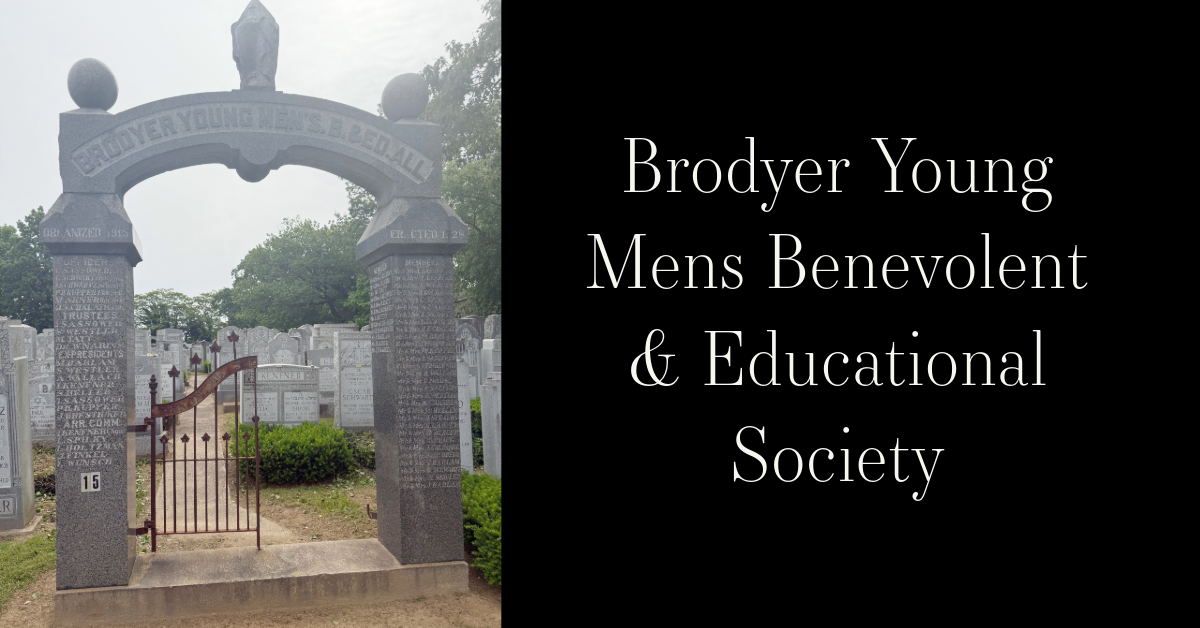
The Brodyer Young Men Benevolent and Educational Alliance Society was established in New York by immigrants hailing from Brody, Ukraine. The society was incorporated on November 11th, 1915, and provided philanthropic, financial, and sick assistance. They also functioned as a burial society, using Mount Hebron Cemetery, Mount Lebanon, Beth David, and Beth Moses. Initial Jewish presence in Brody dates to the 16th century. They engaged mostly in commerce and crafts, acquiring the title of "The Jewish Amsterdam of the East". The Jews of Brody were extremely involved with their community, politically, religiously, and socially. Numerous relief organizations were established to help those in need after attacks and fires. Jewish way of life was dismantled and eliminated following the German invasion of Brody in July of 1941. Just over 200 people survived at the time of the town's liberation on July 18th, 1944, many of whom migrated overseas shortly after the war. Their memories continue to live on. ~Blog by Olivia Scanlon
Learn More
The Minsker Independent Benevolent Association was founded in New York on December 27th 1892 by immigrants hailing from Minsk, today the capital of Belarus (since 1991). The society provided loans and benefits to its sick and distressed members. Initial Jewish settlement dates to the 16th century. The Jews of Minsk made their livings through the merchant and artisan professions. The community became a center for religious scholarship, the Jewish Zionist movement, and the labor movement. German forces entered the city in June of 1941. By July 1942, about 85,000 people had lost their lives. Just over 5000 people survived the Holocaust. Their memories live on. ~Blog by Olivia Scanlon
Learn More
The 1st Kopyczyner KUV (Erste Kopyczyncer Kraken Untershtitsung Verein) society was founded in 1895 by immigrants hailing from Kopychintsy (Kopyczynce), Ukraine. The society was dissolved during the 1920s. Initial Jewish presence in Kopychintsy dates to the 17th century. The Jews of Kopychintsy worked as craftsmen and traders. During the 20th century, the community established numerous communal institutions/unions, and engaged heavily with the Zionist movement of the period. The town was liberated on March 23, 1944. Only 20 Jews survived the Holocaust. They later traveled overseas. Their memories live on. ~Blog by Olivia Scanlon
Learn More
The First Independent Zinkower Society was established in New York by landslayt from Zinkov, Ukraine. The society, dissolved in 1976, provided burial and funeral expenses. Initial Jewish presence in Zinkov dates to the 16th century. Prior to the Tatar and Turk attacks, the Jews of Zinkov made their livings through trades, and had established various communal institutions promoting study. The town, and its Jewish population ceased until the 18th century. Repopulation and revitalization of Zinkov is visible from the 18th century up until Nazi occupation of the town. The Jewish population of Zinkov perished during the Holocaust. Their memories live on.
~Blog by Olivia Scanlon
Learn More
The Marmaros Benevolent Association was founded in 1917 by immigrants hailing from Marmaros (Sighet Marmaţiei), Romania. The society held charities and other social events. They have subsidized burial at Mount Hebron Cemetery. Initial Jewish presence in Sighet Marmaţiei dates to the 17th century. The Jews of Sighet Marmaţiei maintained Jewish schools, Yeshivot, a library, and a number of synagogues. Following the Hungary occupation in 1940, and the reoccupation of Hungary by German forces in 1944, the Jews were subjected to severe anti-semitic legislation and ghetto conditions. After the war, about 2000 Jews returned, but eventually migrated overseas. The Klaus Wijnitzer Synagogue, in addition to some other memorials, can be visited today. Their memories live on.~Blog by Olivia Scanlon
Learn More
The Jacob (Von) Neuschatz Lodge Society was established in New York by immigrants hailing from Iasi, Romania. Initial Jewish presence in Iasi dates to the 16th century. By the 17th century, the Jews of Iasi were maintaining their own synagogue and cemetery. Many made their living as traders, craftsmen, lawyers, musicians, and doctors. Despite the anti-semitic attacks of the 19th and 20th century, the Jewish community of Iasi flourished, establishing numerous religious and educational institutions/organizations. Much of the Jewish community migrated after WWII, with about 3000 Jews remaining by 1975. In 2003, there were just over 500 Jews remaining, with 4 synagogues still active. Their memories live on. ~Blog by Olivia Scanlon
Learn More
The Bacau Roumanian Ladies Society was established in New York by immigrants from Bacau, Romania. There exists evidence that a Jewish community was established by the 17th/18th century. The Jews of Bacău were heavily communally and politically involved, contributing greatly to the developments of the town. The 1940s brought severe hardships for the Jewish community of Bacau while under Ion Antonescus' rule. In 2004, there remained only over 300 Jews in Bacau. The lives and memories of the Jews of Bacau live on. ~Blog by Olivia Scanlon
Learn More
he Chyrower Young Friends Society was established in New York by immigrants hailing from Chyrow (Kyriv, Chirov, Khyrov), Ukraine. It functioned as a burial society, and uses the Beth David, Wellwood, and Mount Hebron cemeteries. Initial Jewish presence dates to the 16th century. The community engaged in craft and trade professions, and was active politically and socially. The establishment of charities, organizations, and schools facilitated cultural growth of the town. The Jewish community of Khyriv perished during the Holocaust. Their memories continue to live on. ~Blog by Olivia Scanlon
Learn More
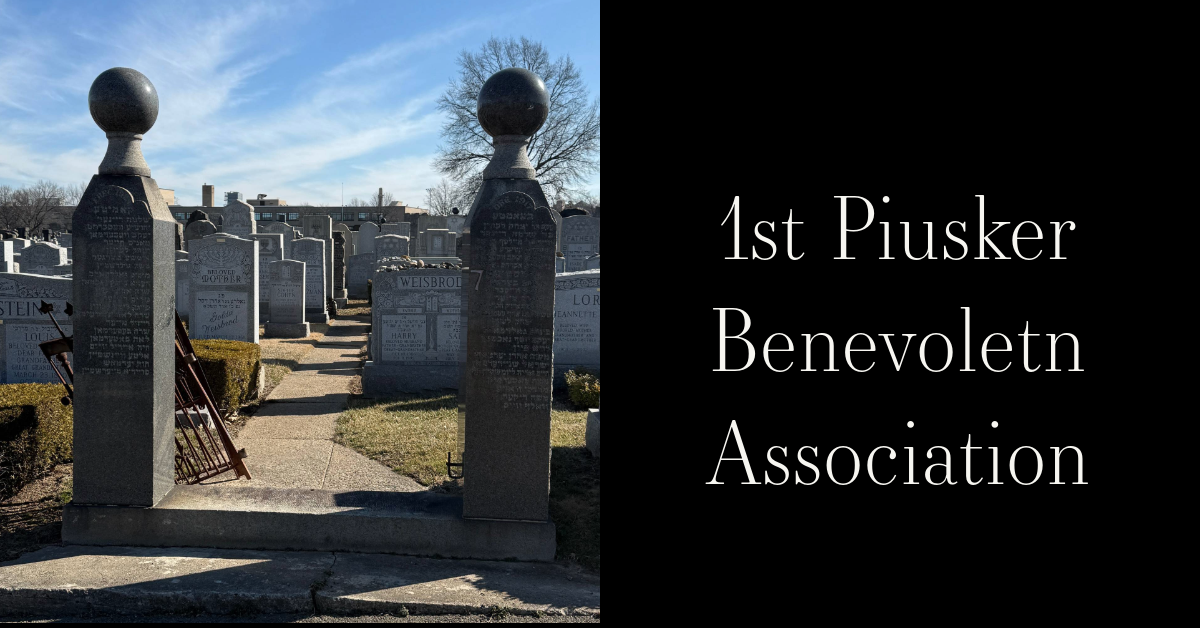
The 1st Piusker Benevolent Association was founded in New York by immigrants from Piaski Luterskie (Piask), Poland. The society was originally known as the "Ershte-Piasker Kranken Unter-shtitsungs Ferayn", and provided sick and death benefits to its members. The Society uses Washington cemetery in Deans, New Jersey and Mount Hebron Cemetery in Queens, New York. Initial Jewish presence in Piask dates to the 17th century. The Jewish population of Piask engaged in commerce and trade professions. Communally speaking, the community was well established, having a synagogue, a cemetery, and becoming industrialized through the influx of factories. During the interwar period, the population suffered heavily from anti-semitic attacks and a worsening economy. German and Soviet forces entered the town in September of 1939. Piasks' Jewish community, as well as some from Germany perished during the Holocaust. By the end of the war, only about 35 had survived. Their memories continue to live on. ~Blog by Olivia Scanlon
Learn More
The First Bukowiner Congregation was established in New York by immigrants hailing from Bukovina (Bukowina), a region today divided between Romania and Ukraine. The earliest Jewish settlement in Bukovina dates to the 14th century. The Jews of Bukovina worked as merchants, craftsmen, and workshop owners, facilitating the economic and industrial growth of the town. The Jewish population of Bukovina rose steadily, with there being over 11,000 by the 1840s. The Jewish community of Bukovina mostly perished in the Holocaust following German and Romanian invasion in 1941. Its survivors emigrated to Israel or the United States. May their memories live on. `Blog by Olivia Scanlon
Learn More
The 1st Baranower Sick and Benevolent Society was founded in New York by immigrants from Baranow, Poland. Initial Jewish presence dates to around the 14th century, however, due to the political environment at that time, the Jewish population ceased, and was not re-established until the 18th century. Jewish population increased steadily up until the 19th century. A synagogue and cemetery was established sometime in the 18th century. During the 19th and 20th centuries, the Jewish community faced severe economic hardships, resulting in mass migrations to neighboring areas and/or overseas. The Jewish community of Baranow perished in the Holocaust. Their memories continue to live on. ~Blog by Olivia Scanlon
Learn More
The Stuchiner Young Men's Society was established in 1948 by immigrants from Szczuczyn, Poland. Initial Jewish settlement dates to the 18th century. The Jews of Szczuczyn engaged in trade and crafts, working as tailors and shoemakers. The town had a synagogue, multiple heders, prayer houses, a Talmud-Torah school, and a Yeshiva. The community also established and maintained many zionist branches and charities, holding classes and helping those in financial need. The Jewish community of Szczuczyn suffered greatly following the German invasion on September 7th, 1939. The memories of Szczuczyns' Jewish community lives on. ~Blog by Olivia Scanlon
Learn More
The First Independent Weislitzer Benevolent Association was founded in 1909 by immigrants hailing from Weislitz (Wislica), Poland. The society, dissolved in 1995, held social events, and provided death and sickness benefits/aid to its members. The society has subsidized burial at the Beth David and Mount Hebron cemeteries. Initial Jewish presence dates to the 16th century. The Jewish community of Wislica engaged in the professions of moneylending and trade, and maintained multiple communal institutions, such as the synagogue, prayer houses, a mikvah, and a cemetery. The Jews of Wislica perished during the Holocaust. Their memories continue to live on.
Learn More
The Bobrka Benevolent Society was established by immigrants hailing from Bobrka, Ukraine. Initial Jewish settlement dates to roughly the 15th/16th century. Jewish population in Bobrka increased steadily until the 1890s. By the 1930s, however, due to the surrounding political and economic situation, many emigrated, with about 1800 Jews remaining in 1931. The Jewish community of Bobrka was well established, maintaining its synagogues, heders, Zionists organizations, and engaging as merchants in trade. The Jewish community became the target of attacks during WWI. Bobrka's Jewish community perished following the German invasion in 1941. In 1944, about 40 Jews returned. Their memories live on.
~Blog by Olivia Scanlon
Learn More
The 1st Ottynier Lodge Society was established by immigrants hailing from Ottynia, Ukraine. Initial Jewish presence dates to around 1635. Ottyniers' Jewish population largely engaged in professions as merchants, craftsmen and factory workers. The social and economic situation of Ottyniers' Jews severely worsened at the outbreak of both World Wars. While there is not much information on the situation surrounding Nazi occupation, we know that Ottyniers' Jews, including those from surrounding areas were transported to Stanislawow and/or the Belzec extermination camp. Today, memorials/monuments stand remembering the lives of memories of Ottynia's Jewish community that perished in the Holocaust. Their memories will continue to live on. ~Blog by Olivia Scanlon
Learn More
he Independent Reiziner Society was founded in 1913 by immigrants hailing from Ruzhin, Ukraine. The society provided both sick and death benefits to its members. Subsidized burial can be found at Mt. Hebron Cemetery. While there is no concrete date for initial Jewish presence in Ruzhin, we do know that the town's Jewish cemetery began its burials near the mid-1770s. Ruzhin maintained itself as a communal and industrial town, establishing factories of different sorts and erecting hospitals, churches, synagogues, and educational institutions. During WWI, Ukraine was the target of pogroms, with Ruzhins' Jewish population subsequently decreasing. The Jewish community of Ruzhin perished following the German invasion of the town in July of 1941. Today, monuments located at the German killing sites continue to be visited, and the lives of Ruzhins' Jewish community are remembered.
~Blog by Olivia Scanlon
Learn More
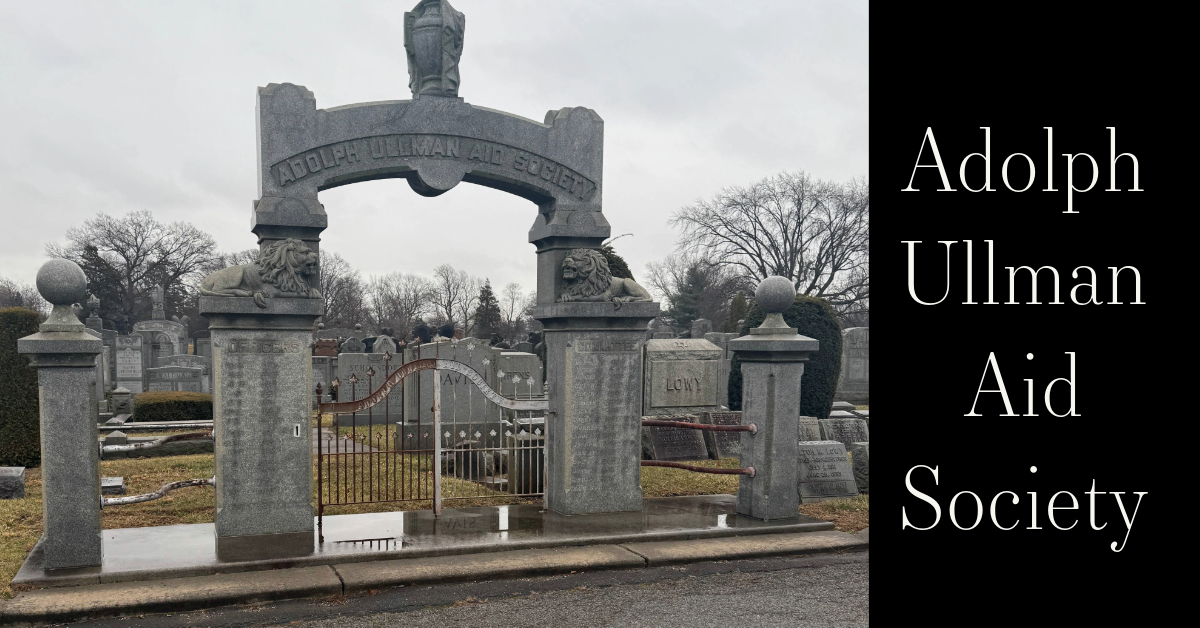
The Adolph Ullman Society was established in 1898. While the society is not connected to a specific town, its members mostly hail from Austria/Hungary and (mostly Eastern) Galicia. Adolph Ullman himself belonged to a prominent business family active in 19th century Hunga-ry.
Jewish life in Austria dates to the tenth century, gaining high recognition by the 1930s for its social and cultural advancements. Following its annexation in 1938, however, the Jewish people were subjected to harsh persecution. By the end of the war, over 65,000 Austrian Jews had per-ished. Following its joining of the Axis Powers in 1940, Jews of Hungary (~500,000) were also subject to persecution and perished. Once having gained full rights following the 1867 constitu-tion, the social, cultural, and religious aspects of Galicia's Jewish community flourished. Today, Galicia lies within the borders of Poland and Ukraine, with its Jewish population largely concentrated towards the East. May their memories live on. ~Blog by Olivia Scanlon
Learn More
The Glogower "UV" Society was founded in 1896 by immigrants who hailed from Glogow (Glogow Malopolski, Glogau (German)), Poland. It was incorporated in 1937. The society provided sick and death benefits. Subsidized burial can be found at Acadia and Mount Hebron (Cedar Grove) Cemeteries. Initial Jewish presence in Glogow, Poland dates to the 13th century. Up until the 1630s, the Jews of Glogow were targets of libels, attacks, and an expulsion. By the 17th century, there were over 1600 members of the Jewish community of Glogow. This number increased to 1800 by the year 1791. Due to many moving to Wrocuaw (Breslaw) and Berlin, the population decreased to 600 by 1925. The remaining 45 Jews of Glogow all perished during the Holocaust. The community was not reestablished following WWII. A monument stands today in memory of them all. ~Blog by Olivia Scanlon
Learn More
The first Dimerer Progressive Association was founded in New York (1919) by immigrants hailing from Dymer (Dimer), Ukraine. The society maintained a loan association and helped those who served in the U.S. Armed Forces during World War II. The earliest known Jewish community in Dymer is known to have existed since/during the Polish-Lithuanian Commonwealth rule. The Jews of Dymer engaged mostly in the areas of trade and craftsmanship. Following the Russian pogroms, the Jewish community decreased significantly. Dymers' entire jewish community perished during German occupation (beginning 1941). Their legacies are carried on by the communal upkeep of the community's Jewish cemetery, and the memorials that have been devoted towards them.~Blog by Olivia Scanlon
Learn More
The Independent Chernolitzer Society was established by immigrants hailing from what is today recognized as Chernivtsi, Ukraine. Prior to the World Wars and during the interwar period, the city passed through the hands of Austrian, Romanian, German and Soviet occupation, resulting in its name changing. This is important to note since birthplaces on official documents reflect the country that was occupying the city at that time. The earliest Jewish community of Chernivtsi dates to 1408. The Jewish community of Chernivtsi contributed greatly to the commercial, political, cultural, and academic growth of the city. Up until the First World War, the population increased steadily, however following the Second World War, its survivors left for Poland, Romania, Palestine, and Israel on travel visas. Today, there are only about 1500 Jews in Chernivtsi, with one functioning synagogue.
~Blog by Olivia Scanlon
Learn More
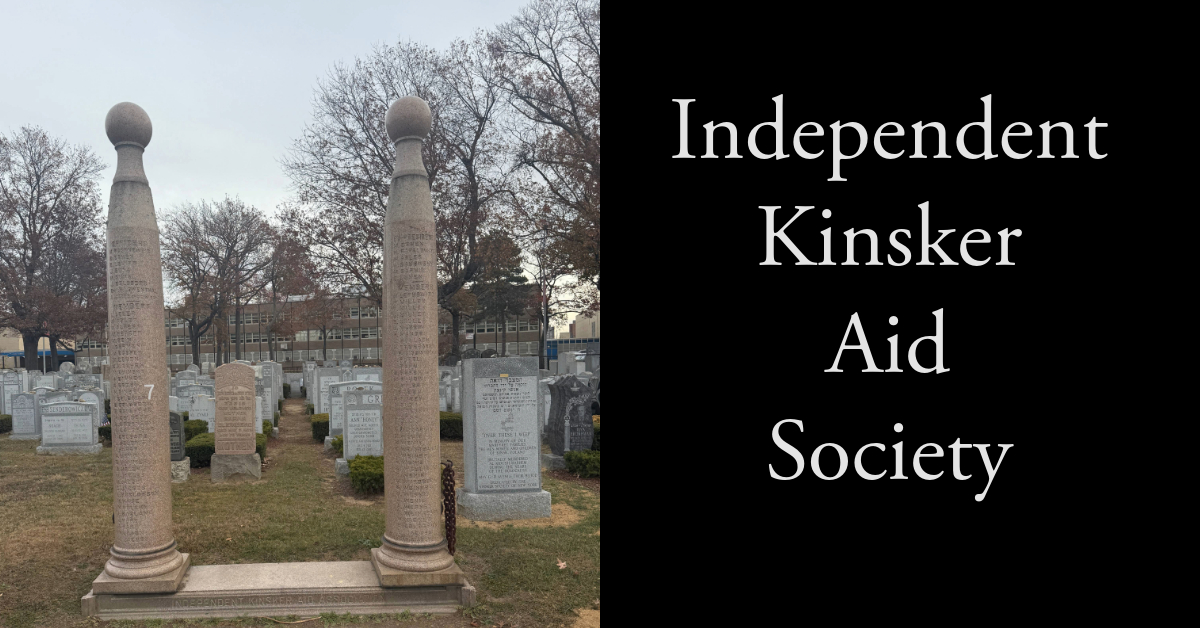
The Independent Kinsker Aid Society was founded in New York in 1904 by immigrants from Konskie, Poland. The society maintained a relief committee after World War II, which aided survivors who came to the U.S. The society also sent food packages to the landslayt in Israel. Research has shown that initial Jewish presence in Konskie began around the 16th century. The Jewish community worked in the areas of trade and craft. Many owned businesses and factories, contributing greatly to the economic and social stability of Konskie. The Jews of Konskie were also involved politically, forming Zionists groups and creating communal organizations. In September of 1939, Germans invaded Poland. A ghetto was established, holding 10,000 Jews (from Konskie and other Polish cities such as Lodz, and Sosnoweic). In November of 1942, the ghetto began to be liquidated. Those who survived the liquidation were sent to the Szydlowiec ghetto. Today, a plaque stands commemorating the lives and memories of Konskies' Jewish community.
Learn More
The Adler's Young Mens Independent Association was founded in New York in 1884 by immigrants from Kovno (Kaunas), Lithuania. Named after Rabbi Israel Salander Adler, the association provided sick and death benefits, and functioned as a burial society. The society also maintained both a free loan fund and relief fund. The society (dissolved in 2002) uses Mount Hebron Cemetery and Washington Cemetery. Having settled in 1410, the Jews of Kovno engaged in numerous professions and endorsed both religious and cultural life. Many were exiled following the Soviet invasion of Lithuania in June of 1940. After German occupation later that month, about 35,000 people were relocated into the Kovno ghetto. Many were either deported or killed at Fort IX. When the town was liberated by the Soviet Army in August of 1944, only about 500 had survived. We are able to learn of the experiences of those who perished by way of their diary entries, photographs, and drawings. May their memory live on.
Learn More
The Bendiner Warschauer Benevolent Society was a burial society founded in New York by immigrants from Warsaw and Bendin (Bedzin), Poland. The society uses both Mt. Hebron cemetery and the Beth-El cemeteries of New York and New Jersey.
Learn More
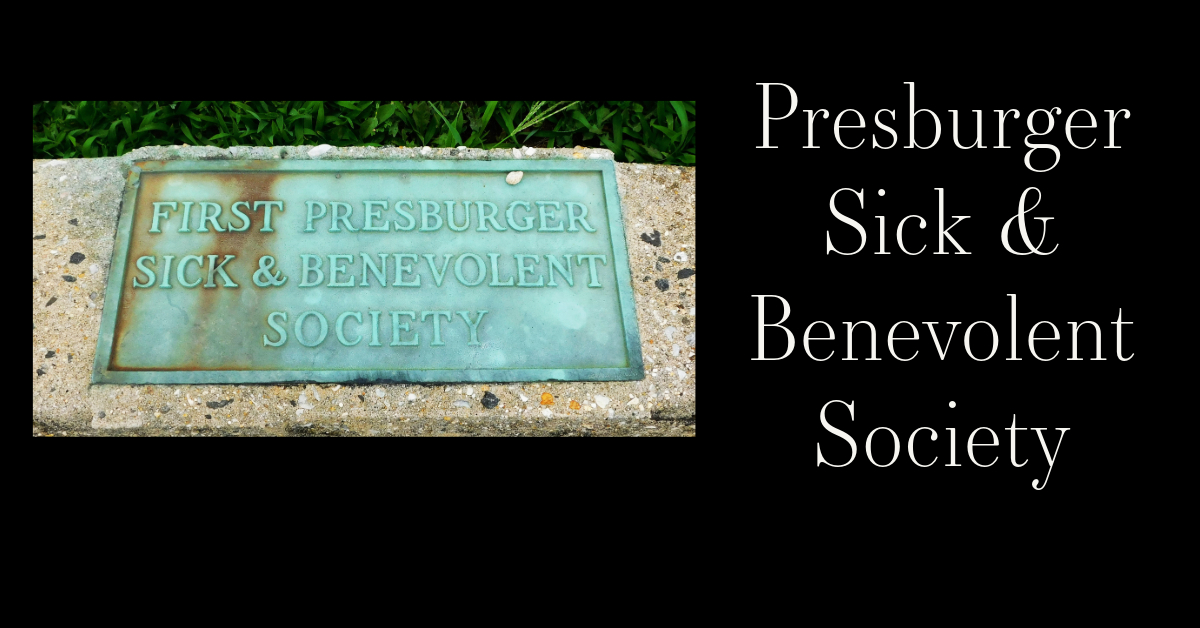
he Pressburger Sick and Benevolent Society was founded in New York by immigrants from Bratislava, Slovakia. The society was dissolved in the 1970s. Jewish presence in Bratislava dates to the 13th century, however due to repeated expulsions, the Jewish community was not able to permanently settle in the town until the 17th century. The Jews of Bratislava flourished in the textile trades, commerce, and moneylending professions. The community established religious and communal institutions such as yeshivas, hospitals, and cemeteries. Charity organizations were also established to help aid those in need. The Jews of Bratislava were very politically involved. Prior to the outbreak of WWII, the Jewish community of Bratislava was subjected to extreme anti-Jewish legislations and decrees. This resulted in the loss of their shops, homes, and livelihoods. The Jewish community of Bratislava perished during the Holocaust. After liberation, the Jewish community was restored, however many began to flee following the Soviet invasion in 1968. By the early 2000's, there were less than 1000 Jews residing in the town.
Learn More
The Lomzer Young Men's Benevolent Association was founded in New York in 1898 by immigrants from Lomza, Poland. The society was created as a means to aid landslayts. In 1937, the society joined with four other Lomzer organizations, and together, formed the United Lomzer Relief Committee to aid the inhabitants of Lomza. The society also sponsored loan funds that went towards aiding the poor. Jewish presence in Lomza dates to the 14th century, however due to a "non de tolerandis Judaeis", the Jews of Lomza were only able to begin establishing themselves as a community by the 19th century. They flourished in the trade and artisan professions and created a number of industrial societies. The Jewish community of Lomza equally took part in politics, supporting the Zionist Movement, and creating political organizations to endorse Jewish activism. The community also maintained a number of cultural organizations and institutions such as libraries and theater groups.
Learn More
The Makower Young Men's Aid Society was founded by immigrants from Makow, Poland in 1907. The society is affiliated with United Relief, which was established after WWI to help aid "landslayts" (neighboring Jews). It was re-established after 1945 to help aid WWII survivors. The Jews of Makow made a comfortable living by engaging in the trade and artisan professions. Communally, they established two cemeteries, synagogues, schools for the youths, libraries, and a cultural/education theater program. Despite the economic and political environment of the 1930s, the Jews of Makow maintained their own, engaging in the growing Zionist efforts and creating societies. The ~4000 Jews of Makow perished in the Holocaust, but their memories live on.
Learn More
The first Radomer Congregation was founded in New York in 1903 by immigrants from Radom, Poland. In 1917, the society founded the United Radomer Relief for U.S. and Canada. Although they began residing in the town in the 1560s, permission to do so was repeatedly revoked. It was not until 1814 that the Jews of Radom were able to live and move freely within the town. The community was then able to establish itself more concretely, beginning the works for a cemetery, a synagogue, a hospital, and other communal institutions. The Jewish community made their living in the trade, artisan, and banking professions. They also facilitated and contributed to the industrialization of the town through an influx of factories. Many left Radom and Poland in the 1930s due to pogroms and a worsening economy. Following the German invasion in 1939, almost 32,000 Jews (Radom and neighboring towns) perished in the Holocaust. In 1965, only 7 of Radom's Jews remained in the town.
Learn More
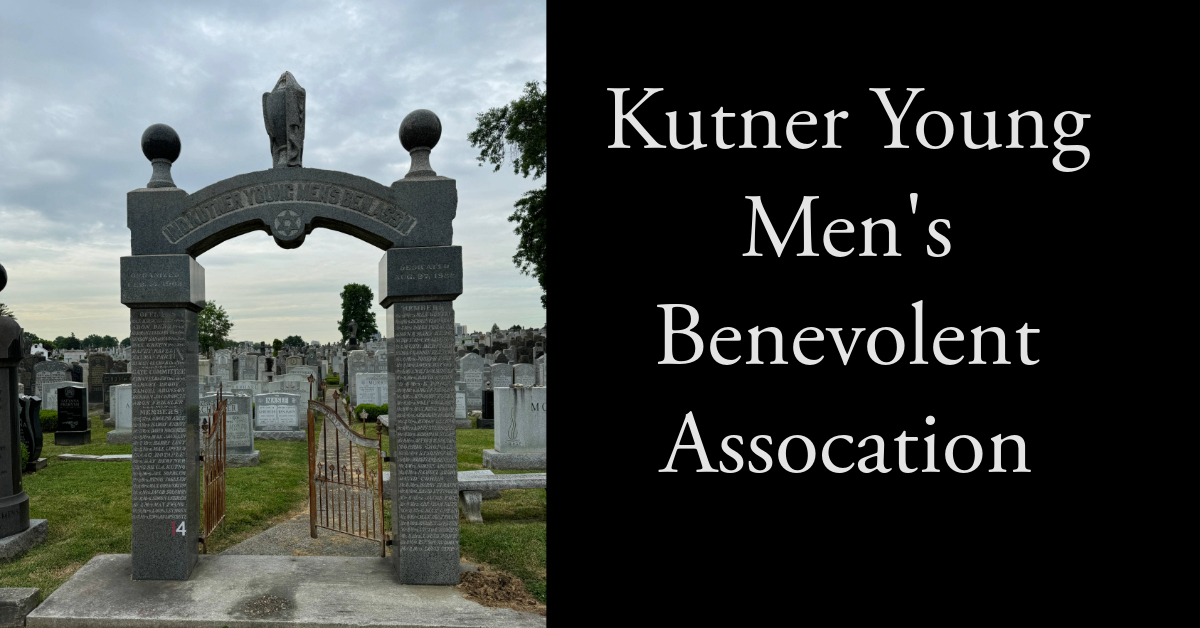
he Independent Kutner Young Men's Benevolent Association was established in 1903 in New York by immigrants from Kutno, Poland. The society provided death benefits and welfare aid to its members. The society uses Mount Hebron cemetery, Cedar Grove cemetery, and the Wellwood cemeteries of Queens and Babylon. While the town's history dates to the 14th century, documentation marks Jewish presence to the 15th century. Professions in crafts and trade were prominent among the Jews of Kutno. Despite their communal-restricted lifestyle, the Jewish community flourished, holding weekly fairs, establishing schools, promoting communal infrastructure, and forming unions. During the twentieth century, the Jews of Kutno involved themselves politically by taking part in government elections and Zionists organizations. From September of 1939 to March of 1942, the Germans implemented the harsh treatment and mass executions of Kutno's Jews. By the end of the war, only 213 Jews from Kutno had survived.
Learn More
The First Ostrowzer Young Men's Benevolent Society, founded by immigrants from Ostrovtse (Ostrowiec), Poland, was created in New York around 1910. The society was dissolved in 2001. Dating their initial presence in the 17th century, the Jewish community of Ostrowiec was economically and communally comfortable. With their own synagogue, a cemetery, and the effects of industrialization, the community grew. Their participation in the 19th century uprisings and Zionists movements allowed the Ostroweic Jews to establish themselves politically. The weakened economy of Poland during World War I resulted in many fleeing abroad. The town of Ostroweic was captured by the Germans following their invasion of Poland in 1939. When the town was liberated by the Red Army in 1945, only 193 Jews remained, with over 10,000 having perished in the labor and concentration camps.
Learn More
The First Zabna Congregation (Erste Zabner Congregation Bnei Shulem David) was founded in New York by immigrants from Żabno, Poland. The society was founded in 1922, and dissolved in 1999. When Jews first settled in the town of Żabno, they were given a number of privileges, such as permission to open/run their businesses, engage in local trade, and have their own place of worship. This allowed them to develop themselves as a community and flourish. Throughout the 18th and 19th century, the Jewish population of Żabno was contingent upon Poland's economy. The 20th century marks the steady decline of Żabno's Jewish population as a result of extreme poverty and devastation from both World Wars. As a result, many Jews left the town, either traveling overseas or settling in nearby areas like Denmark and Saxony.
Learn More
The Kossuth Ferencz Hungarian Literary, Sick, and Benevolent Association was founded in 1904 to help Jewish immigrants from Hungary who settled in New York City. Through membership dues and fundraising events, the group was able to help newcomers make a smoother transition to life in America with affordable medical attention, social activities, literacy assistance, and burial arrangements. This non-profit society, later incorporated as the Kossuth Association of New York, was named for a former Minister of Commerce in Hungary who, like his father Lajos Kossuth, was a dedicated advocate for Hungarian independence. Since Mount Hebron was established, nearly 600 members and their relatives have been buried in the Kossuth Association section, which features stately pillars and gates honoring the group's male and female leaders, all immigrants themselves. - Written by Marian Burk Wood, a descendant of Kossuth founders.
Learn More
The Mirer Young Men's Benevolent and Educational Society was organized July 5, 1903. "Mirer" refers to the town of Mir in Eastern Europe. Mir was founded in the mid 1300's, sometime before 1345. Jews first started settling in the town in the 1600's. The Jewish population in Mir grew rapidly and by the later half of the seventeenth century, the city was noted as having a large Jewish population. Starting around this time, many of the townspeople were traders and merchants, including many in the town's Jewish population. Later in 1815 marked the opening of the Mir Yeshiva. After its opening many of Mir's Jews made money lodging its students. By the end of the 1800's, the town's population was more than half Jews.
~Blog Writtten by Emily Hazy
Learn More
The Zwanitzer Podolier Sick and Benevolent Society was founded by immigrants from what is now Zhavanets, Ukraine to subsidize burials and run charitable events. Members were likely either immigrants from the province of Podolier in the Russian Empire themselves or had parents from Podolier. The region experienced significant emigration in the late 1800's and early 1900's, which greatly decreased the Jewish population of Ukraine. Before this large-scale emigration and the devastation of the holocaust in the 1930's and 40's, more than a quarter of the world's Jewish population lived in Ukraine, with most of these people speaking Yiddish.
~Blog Written by Emily Hazy
Learn More
Founded in 1892 and nationalized in 1900, the Workmen's Circle (now known as the Worker's Circle) is a nonprofit originally set up as a mutual aid organization which also provided health and death benefits. The society, initially known by its Yiddish name Der Arbeter Ring, was founded in an apartment at 151 Essex Street in New York City. The organization was created in the late 1800's in response to the hardships faced by newly arrived Jewish immigrants. These problems included ones previously faced in their home countries such as exploitative business practices and poor living conditions. These were compounded with new challenges such as integrating into a new country while maintaining traditions. Consequently, the Worker's Circle is historically associated with Jewish Unions and Socialist ideals. Early members and applicants were required to be union members and were expected to vote along pro-labor lines.
~Blog Written by Emily Hazy
Learn More
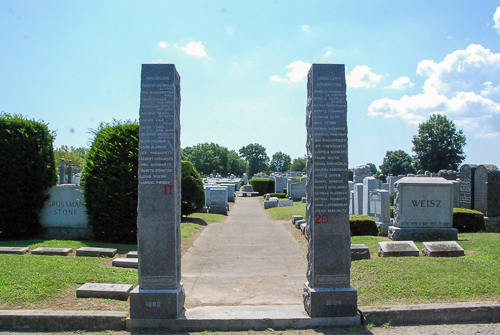
Located on Block 25, Reference 17 is the Freedom Benevolent Society. Initially founded as the Erster Kaiser Franz Josef Kranken Unterstutzungs Verein (First Franz Joseph Sick and Benevolent Society) the Freedom Benevolent Society was founded in 1882 on the Lower East Side of Manhattan by Jewish immigrants from Austria-Hungary. The initial name paid homage to the emperor of Austria-Hungary at the time of the society's founding, before it was renamed in 1940. It is likely that the original members of the organization were from German-speaking communities, given that some early records of the club were written in German. The society was all male. However, it was apparently associated with the Franz Joseph Ladies Sick and Benevolent Society. Less information is known about this society, but it operated at least in the 1930s and 40s. It is likely that the society operated before this, as the earliest death date for a society member buried at Mount Hebron is 1900. The last society member buried in Mount Hebron died in 1991.
Learn More


